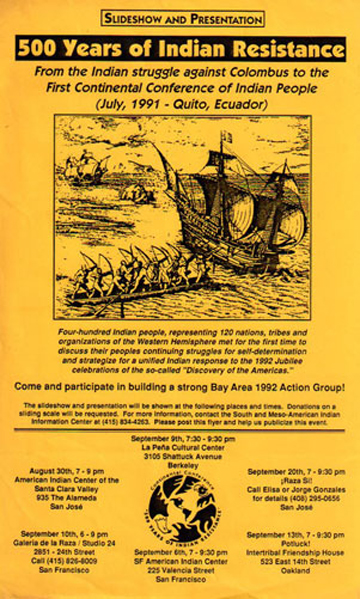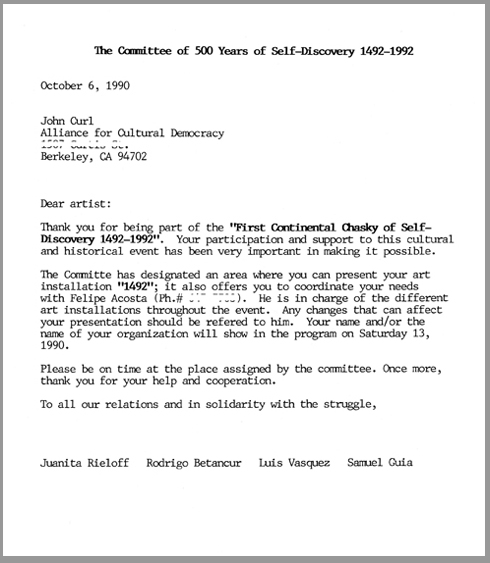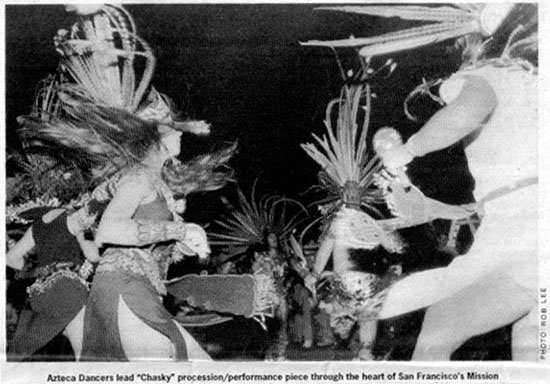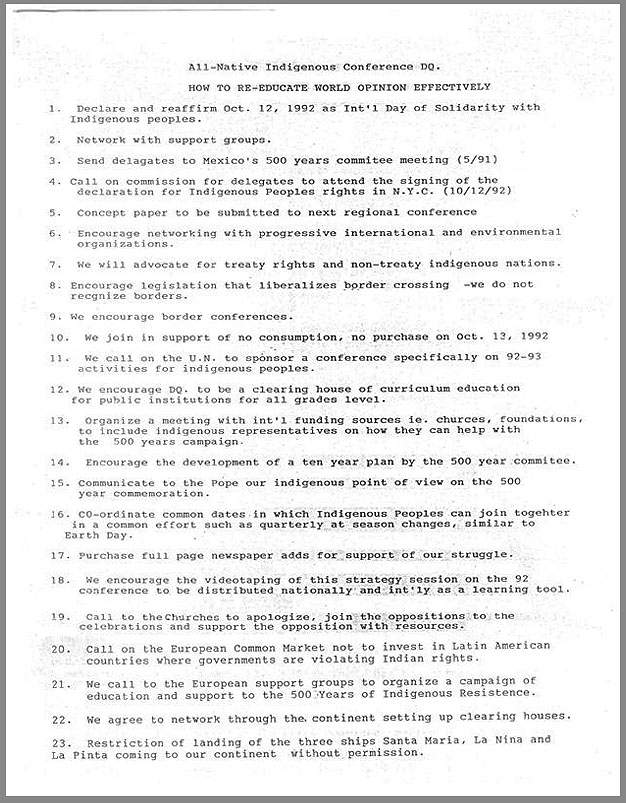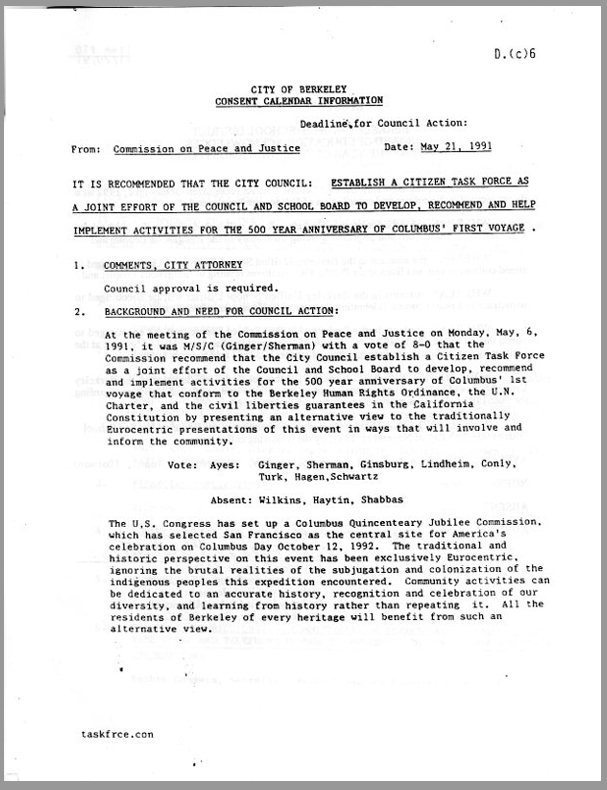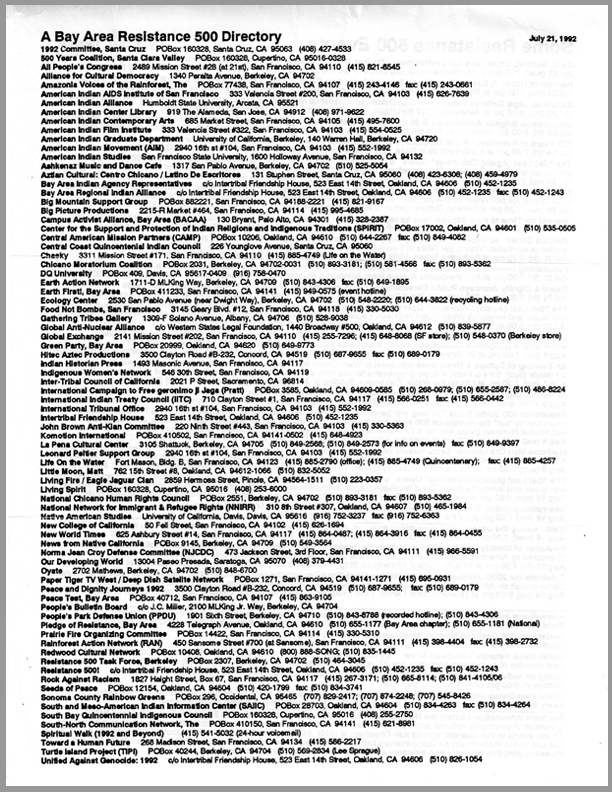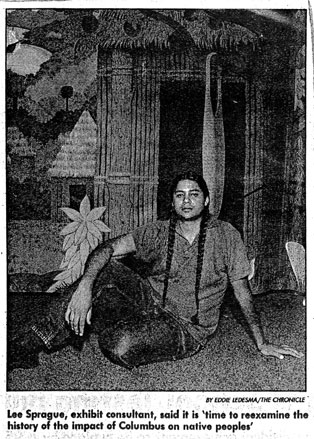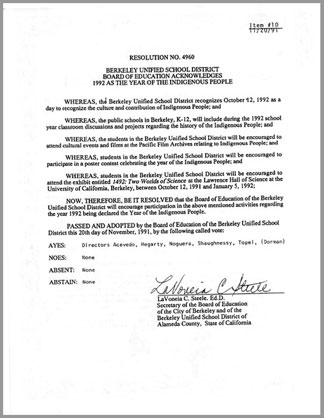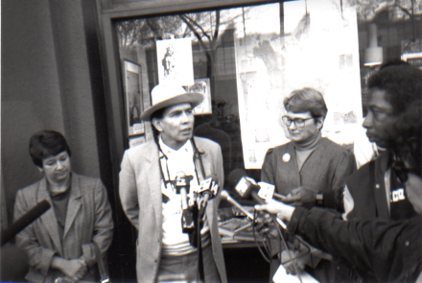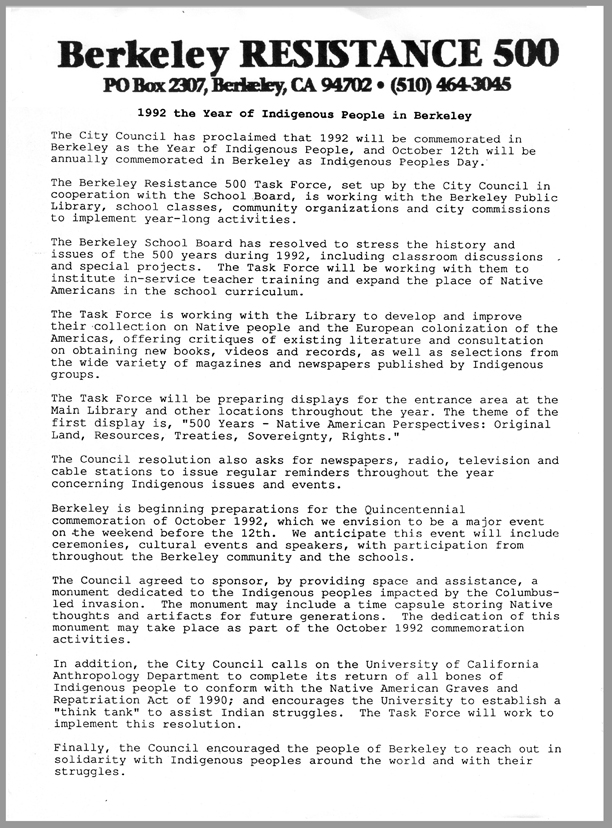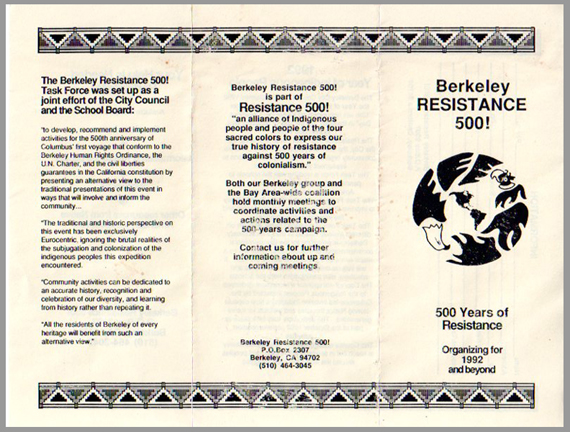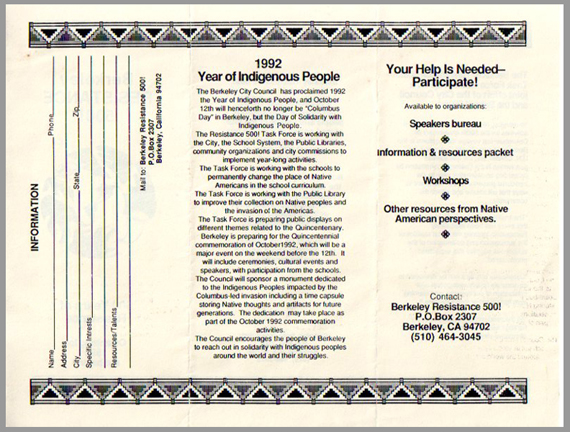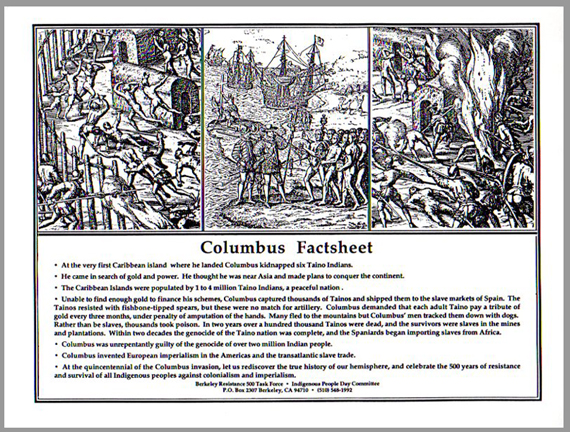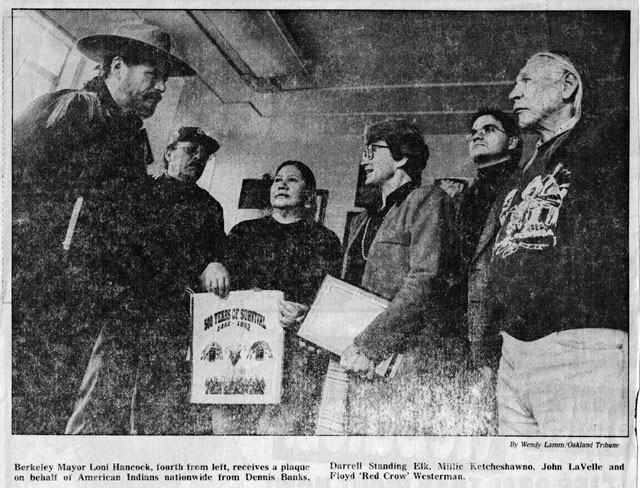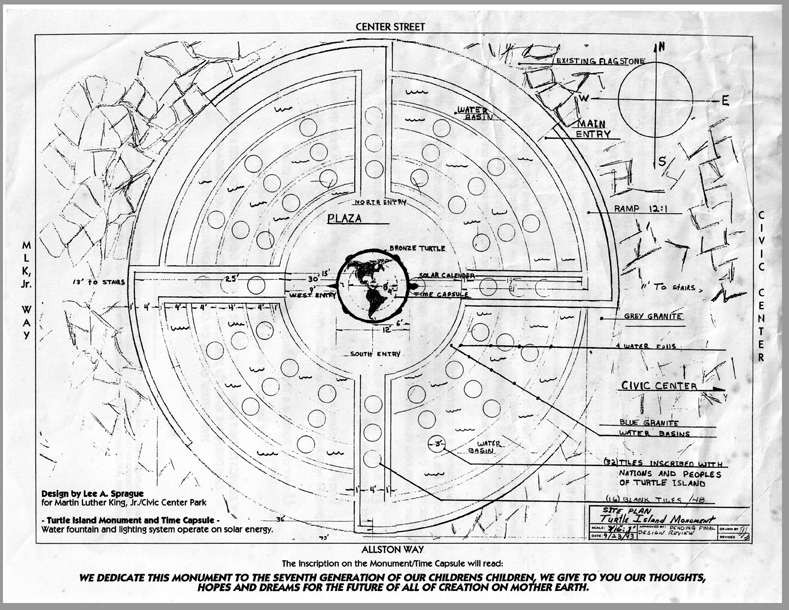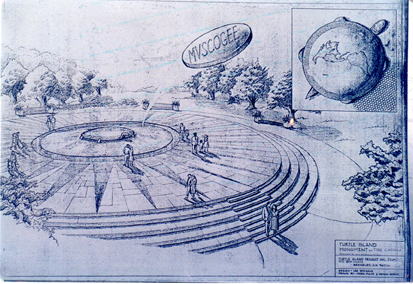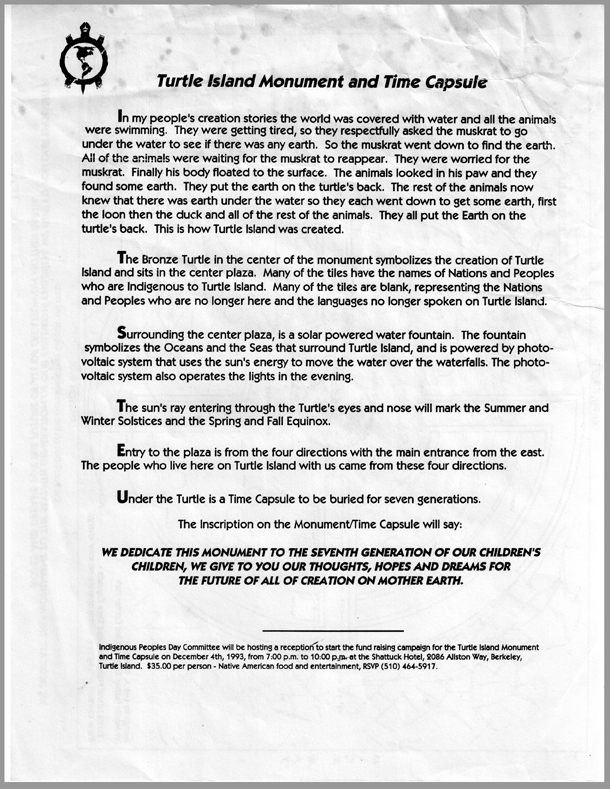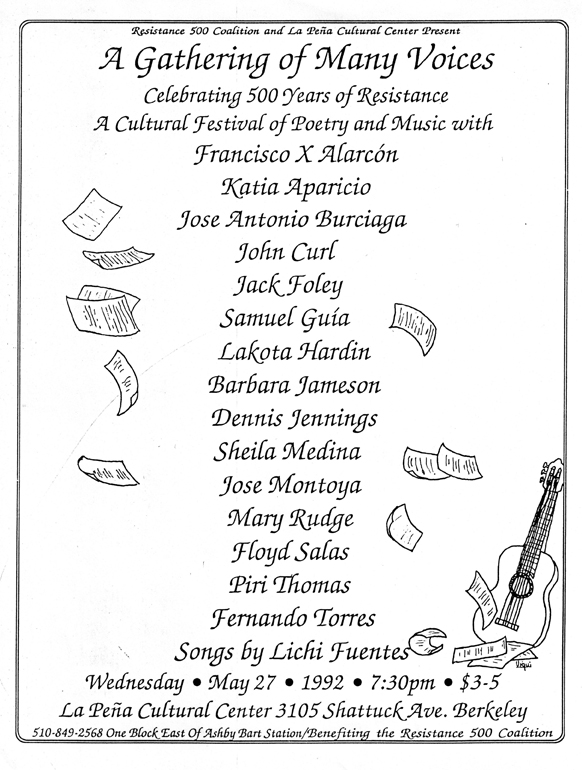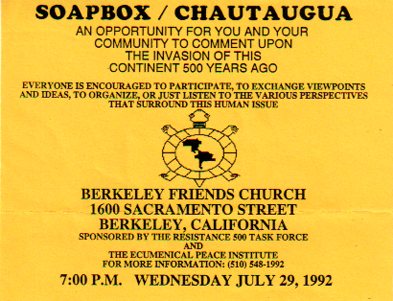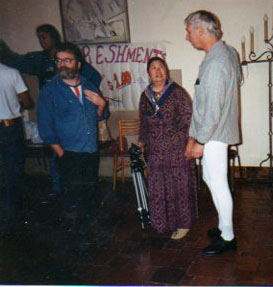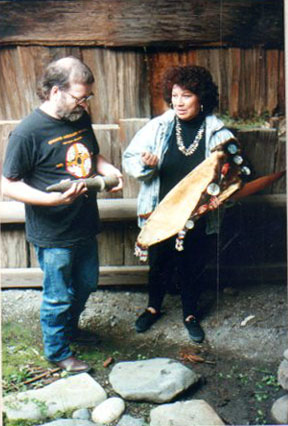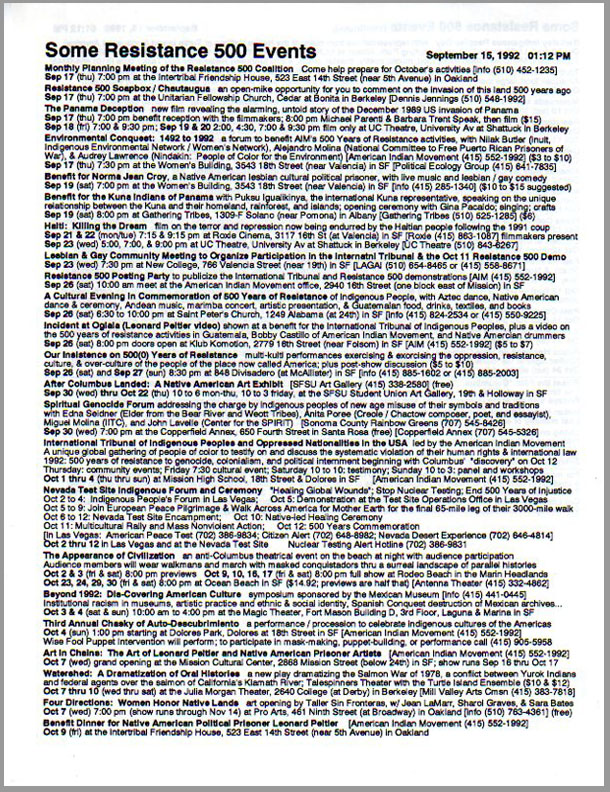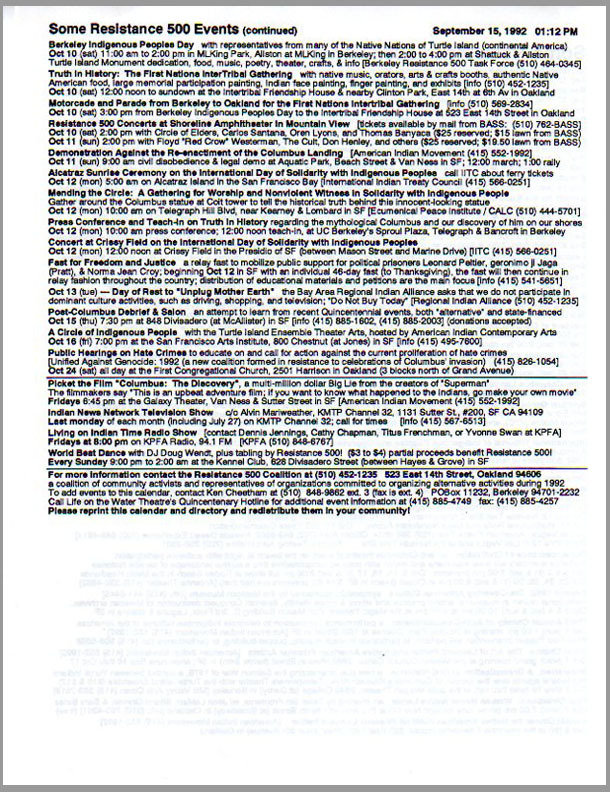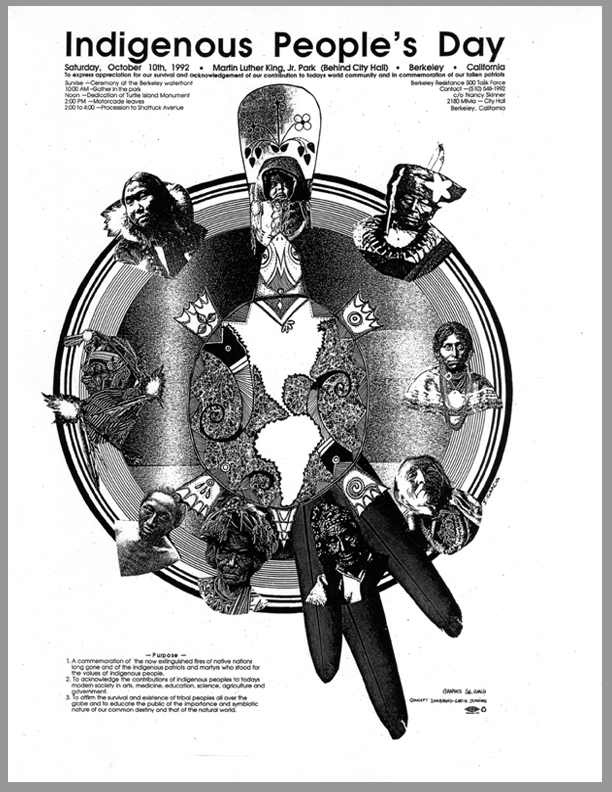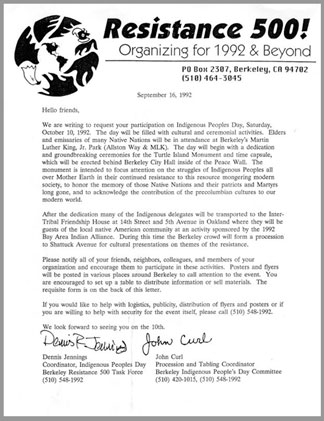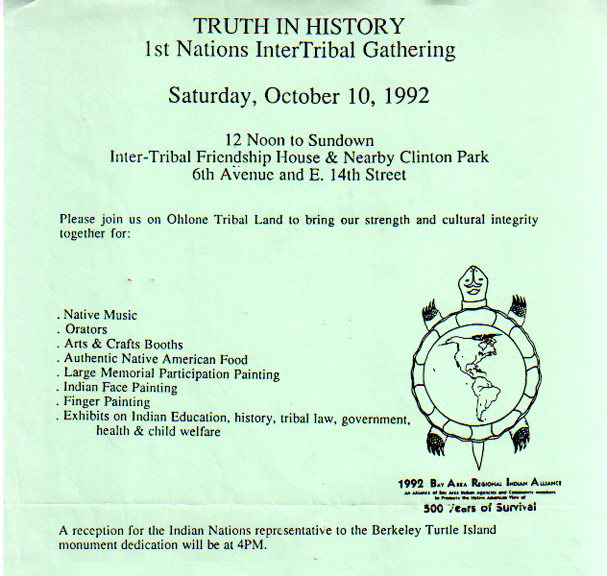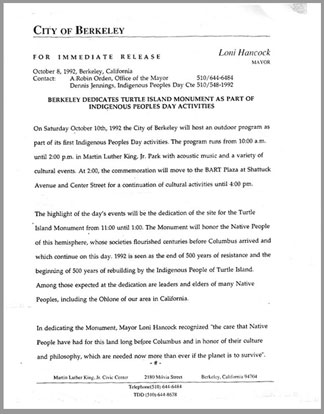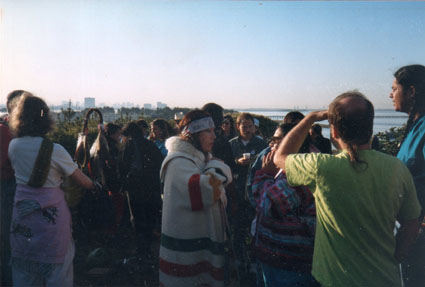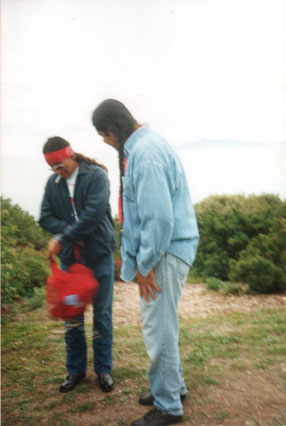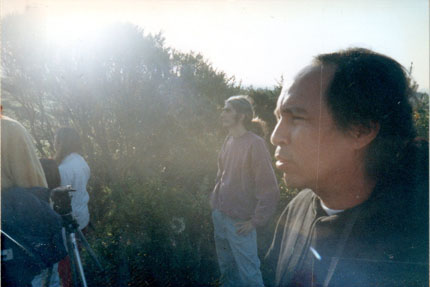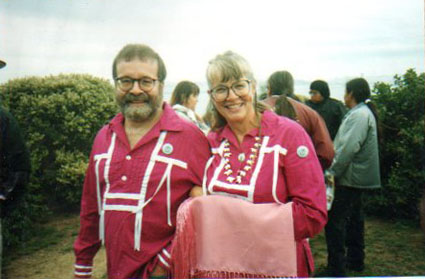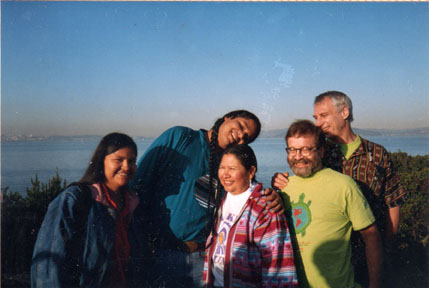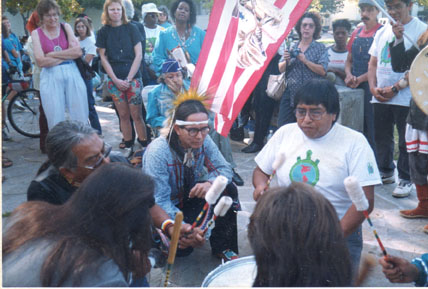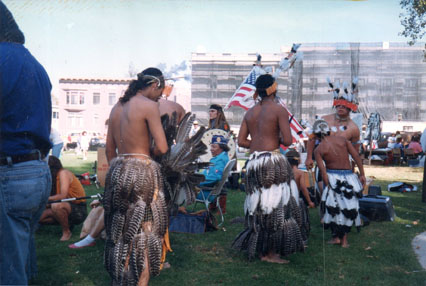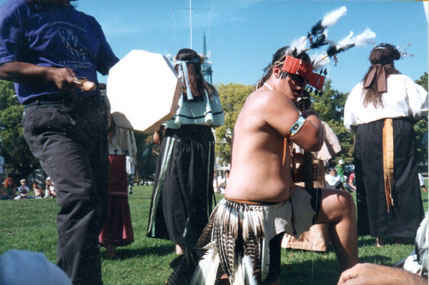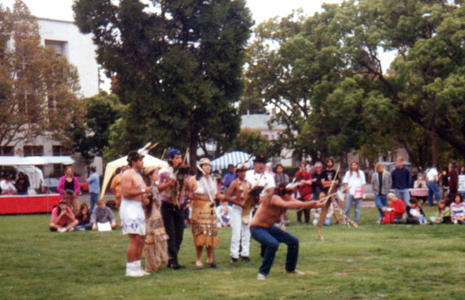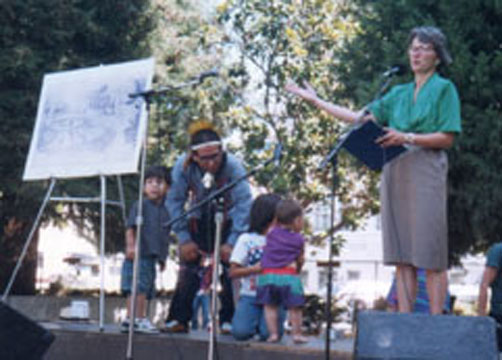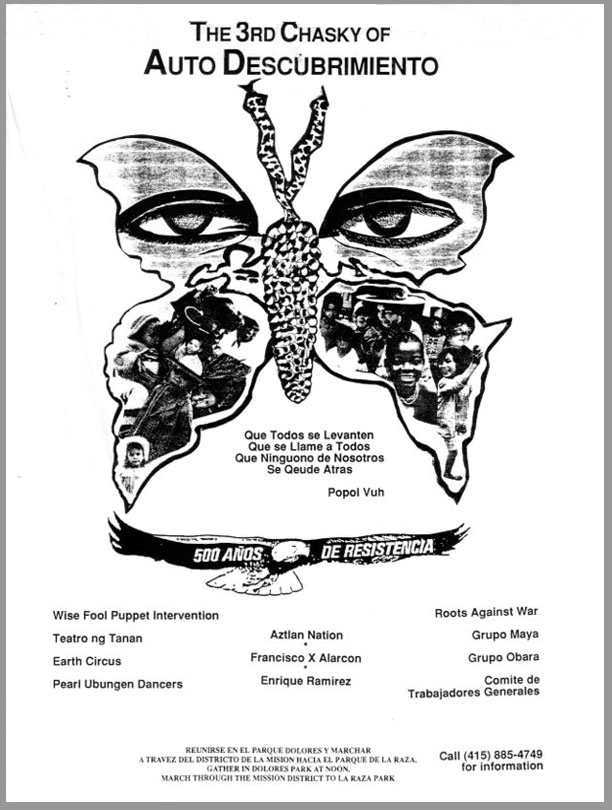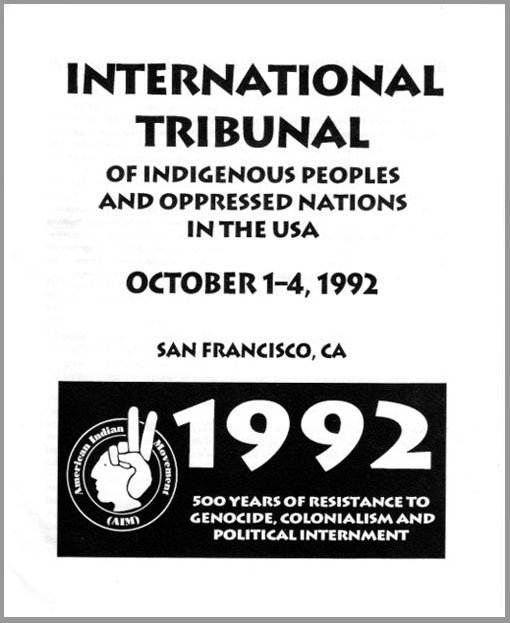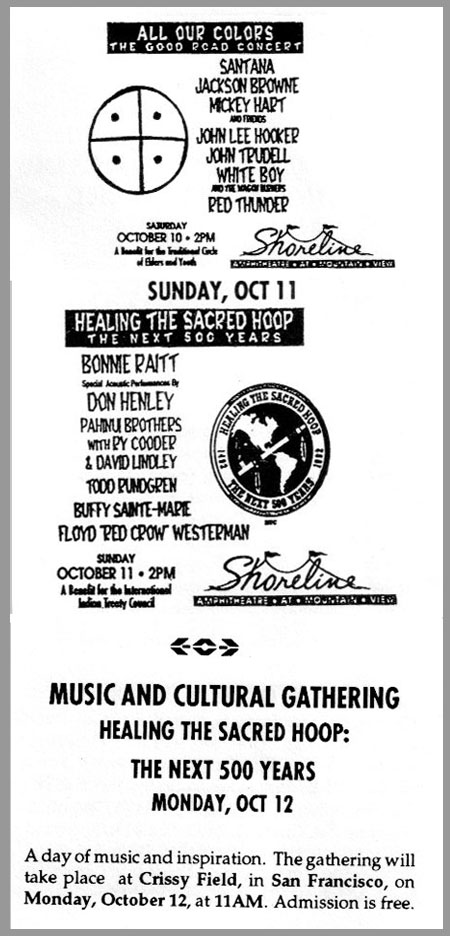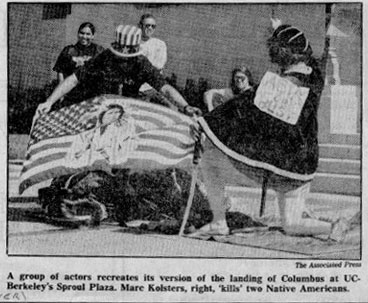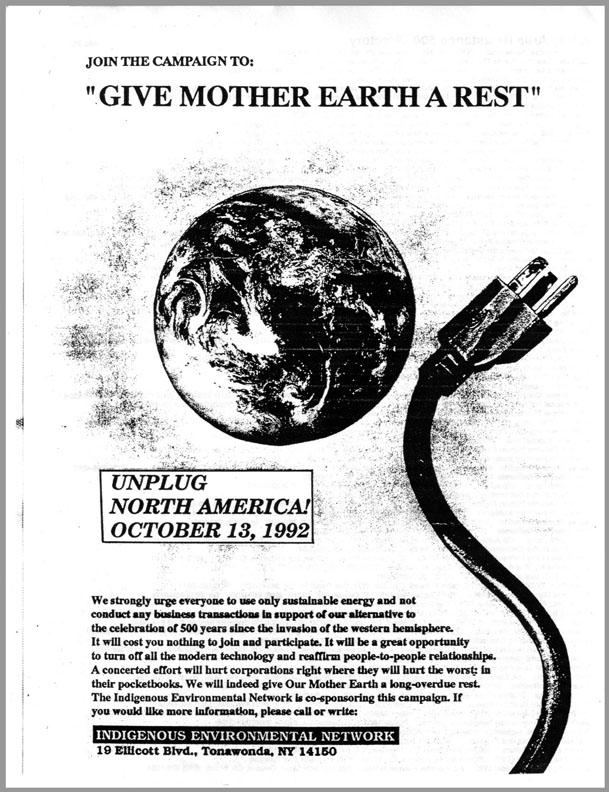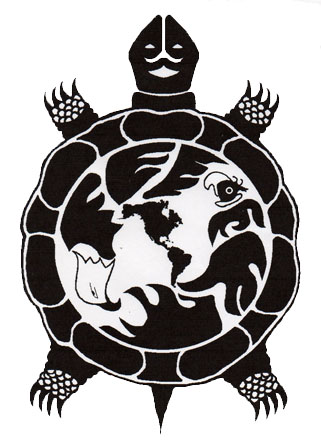The BAY AREA REGIONAL INDIAN ALLIANCE
& RESISTANCE 500
1991
“HOW TO RE-EDUCATE WORLD OPINION
EFFECTIVELY:
1. Declare and
reaffirm October 12, 1992 as International Day of
Solidarity with Indigenous People."
Resolution of the All-Native Indigenous Conference,
D-Q / 1992 All Peoples Network
Conference
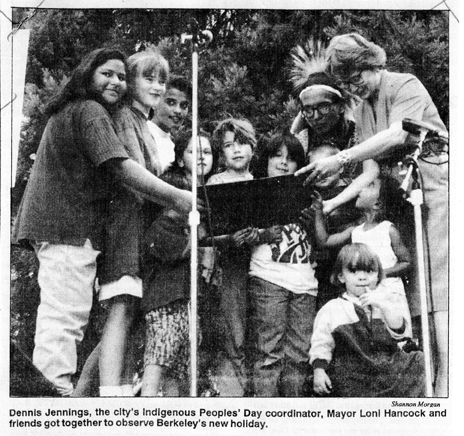
The First Berkeley Indigenous Peoples Day 1992 [Berkeley
Voice 10/15/92]
Shortly after I returned from the July, 1990 Encuentro in Quito,
Ecuador, I set up a meeting with Berkeley Mayor Loni Hancock to report
back and to begin plans for the quincentennial, which was quickly
coming
up. The meeting was originally scheduled to be just three people: Mayor
Hancock (as whose representative I had arranged to go to that momentous
gathering), Nilo Cayuqueo (director of the South and Meso American
Indian Information Center, a central organizer of the Encuentro), and
myself.
Nilo brought two people with him, neither of whom I knew until then:
Antonio Gonzales and Millie Ketcheshawno. Tony was director of the
International Indian Treaty Council (IITC); Millie had played an
important role in the Alcatraz Island occupation of 1969-1971, and had
been the first woman director of Intertribal Friendship House in
Oakland (a primary center for the Bay Area Indian community). Tony was
Seri/Chicano, and Millie was Muscogee. Neither Tony nor Millie had been
to the Encuentro, but both would play important roles in the events to
follow.
Neither the IITC nor AIM had been an organizing group of the Quito
Encuentro. Historical and cultural differences apparently had
caused distance between North American and Latin American
Indigenous organizations. The histories of domination and oppression by
the different
north/south colonial powers had taken very different turns, resulting
in many obstacles hindering the respective Native peoples’ mutual
understanding. The Encuentro organizers had apparently tried to
sidestep
those problems by making SAIIC the North American organizing group,
even though SAIIC was not based in northern Native peoples. As a
result, all US
and Canadian people at the Encuentro, including those affiliated with
IITC and AIM, had attended as individuals, not as organizational
representatives.
But back here in the Bay Area everything was different. Nilo must have
realized that to proceed, SAIIC had to form a coalition with the
Northern Native nations’ progressive organizations, such as IITC and
AIM, and that is what SAIIC did.
In 1990, as today, the Bay Area was home to one of the largest
concentrations of
urban Indians in North America. Around 40,000 Native Americans of many
tribes and nations lived in the area, as well as 800,000 Latinos, most
of whom were part or wholly Indigenous.
At the meeting in the mayor's office, Nilo and I reported to Loni about
the Quito Encuentro. Millie and Tony already knew about it, since word
had spread quickly in the Indigenous community. Then the four of us
passed the next hour or so brainstorming about how to proceed.
Loni suggested that we needed to get the city to set up an official
“task force” to study the issues and report findings and
recommendations. First we would need to thread our way through the city
processes of boards and commissions. The most important bodies would be
the Peace and Justice Commission and the School Board. If we could
garner their support, they would report to the city council, and that
would open the door to the council setting us up as an official task
force. Loni offered to find us a space in city hall to work out of, if
we
needed it.
IITC back at the UN
Earlier that year, at the same time as Nilo and SAIIC had
been organizing the Encuentro, Tony Gonzales
and the ITTC had been busy in New York City at the UN Economic and
Social Council (ECOSOC)
session of May 1-25, 1990, lobbying for the UN to
declare 1992 the International Year of Indigenous Peoples, to declare
the next decade the International Decade of the World’s Indigenous
Peoples, and to declare
October 12 International Indigenous Peoples Day. Tony and the IITC met
with intense
opposition from the US government and other sources. The governments
didn’t want any interference with the 1992 Columbus “Jubilee.” The
result
was that ECOSOC Resolution 248 of May 25, 1990, called for the UN to
proclaim
1993 (not 1992) as the International Year of the World’s Indigenous
People. The concept of “peoples” was also too threatening to
governments, so they removed the “s” and made it “people” instead of
“peoples.” And ECOSOC deferred the proposals for the Decade and
Indigenous Peoples Day. The UN General Assembly would proceed to pass
Resolution
45/164 in December, 1990, proclaiming 1993 (not 1992) the International
Year of the World’s Indigenous People. [2]
Report
Back and Slide Show
The first public informational event about the 1990 Encuentro that
SAIIC
put on, cosponsored by the Alliance for Cultural Democracy (ACD), the
multicultural activist arts group that I had been working with on the
counter-quincentenary project, was a Report Back and
slide show that we presented six times in Berkeley, Oakland, San
Francisco, and San Jose between August 30 and September 20, 1990. I
put together the historical section of the slide show from 16th century
images that I had collected, mostly of Columbus's attacks on the Taino
Indians, while Bobsy Draper and others contributed slides from photos
that they had taken at the Encuentro. The event was very successful and
well attended.
Also in process by SAIIC was a video of the Encuentro. You can watch
the video on YouTube HERE.
THE
CHASKY
At this time SAIIC, IITC, AIM, ACD and over twenty other progressive
political and cultural groups formed a coalition we called The
Committee of
Five Hundred Years of Self-Discovery. Under that banner, we jumped into
the first major counter-quincentennial event in the Bay Area, the San
Francisco Chasky. Among the core members of the organizing group were
Samuel Guía, Rodrigo Betancur, Juanita Rieloff, Felipe Acosta,
and Luis
Vasquez.
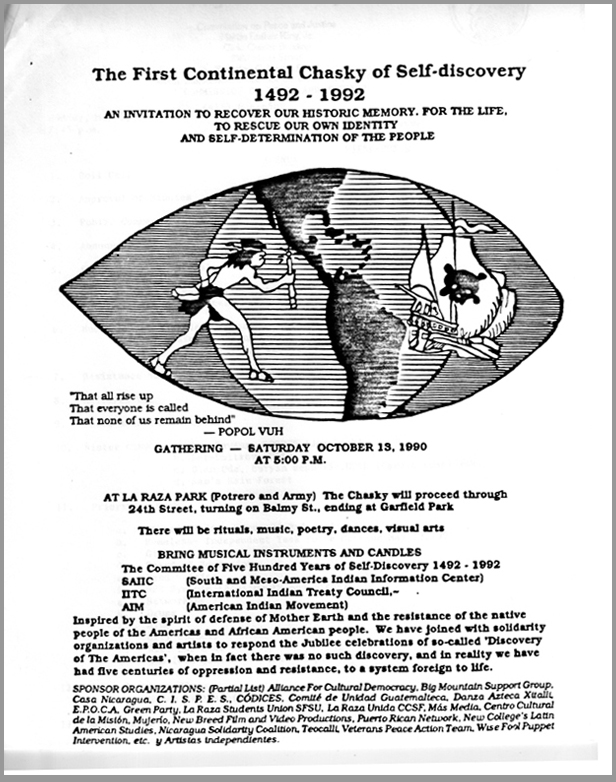
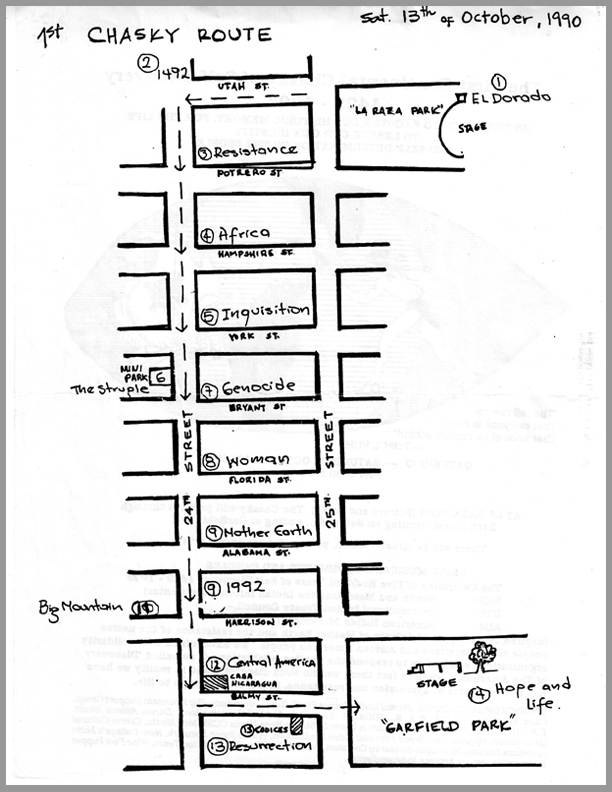
We scheduled the Chasky for Saturday, October 13, 1990. Chaskys were
the runners who during Inca times delivered messages over long
distances across the Andes. The first Chasky flyer stated that it was
"An invitation to recover our historic memory. For the life, to rescue
our own identity and self-determination of the People... Inspired by
the spirit of defense of Mother Earth and the resistance of the native
people of the Americas and African American people. We have joined with
solidarity organizations and artists to respond to the Jubilee
celebrations of so-called ‘Discovery of The Americas’, when in
fact there was no such discovery, and in reality we have had five
centuries of oppression and resistance, to a system foreign to life.”
The Chasky procession started at the stage in La Raza Park on 25th
Street, San
Francisco, with ceremonies, speakers, and music. The crowd then walked
over to 24th street, and turned east, gathering passersby as we
proceeded. At each corner for ten blocks was a cultural presentation on
a different theme: 1492; Resistance; Africa; Inquisition; The Struggle;
Genocide; Women; Mother Earth; 1992; Big Mountain; Central America;
Resurrection. It finished with another round of ceremonies, speakers,
and music on the Garfield Park stage, where the theme was Hope and
Life. The Chasky was a very successful event.
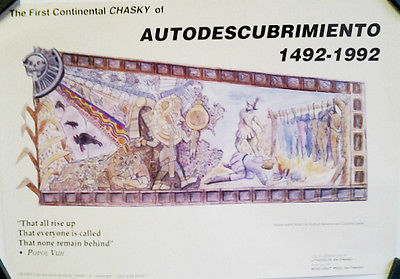
Poster by
Rodrigo Betancur and Elizabeth Dante
First Chasky (Huracán Fall/Winter
1990)
The following year, on October 12, 1991, with Luis Vasquez as the
central organizer, the Chasky reversed the route, beginning in Garfield
Park and finishing in La Raza Park. It again used "a variety of
performances and visual art as a strong statement of cultural,
spiritual, and political identity," and meant to be "a rallying point
and touchstone for many groups... to work in harmony to dedicate the
next twelve months to opposing the quincentenary celebrations in 1992."
We would adapt the chasky concept into the events of the first Berkeley
Indigenous Peoples Day in October, 1992.
The first Chaskys did not actually declare the event to be a
celebration of Indigenous Peoples Day, even though it included the
same themes. At the time of the first Chasky, in October, 1990, the
concept of Indigenous Peoples Day was still germinating where it lay
since 1977, when it was originally declared by the Geneva UN Indigenous
conference, and I for one was not even very aware of the 1977 Geneva
conference at that time. Even the Quito Encuentro, although all the
participants resolved that they would turn October 12, 1992 “into an
occasion to strengthen our process of continental unity and struggle
towards our liberation,” never actually declared that henceforth
October 12 would be celebrated as Indigenous Peoples Day.
Indigenous Peoples Day would resurface again in March, 1991, at the D-Q
All-Native Indigenous Conference.
D-Q All-Native Indigenous Conference
Bay Area Regional Indian Alliance (BARIA)
In October 1990 SAIIC organized a meeting in Minneapolis, Minnesota, of
North American Native activists as a follow-up to the
Encuentro. There they decided to call a major North American
region (US/Canada) all-Indian conference at D-Q University in
Davis, California, to be followed by a one-day meeting at a Bay Area
location with non-Indian people to develop strategies and to network
together toward a unified action plan for 1992.
The all-Indian conference was scheduled for March 22-24, 1991.
The follow-up one-day conference with nonIndian people was to take
place on the next day, at Laney College in Oakland. To host the D-Q All-Native Indigenous Conference,
they formed a coordinating group called the 1992 Bay Area Regional Indian Alliance.
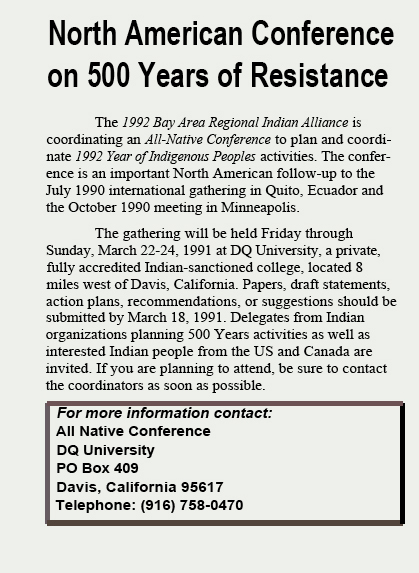
Abya Yala News
(SAIIC)
D–Q University was a two-year Indian college founded in 1975. The full
name of the school was usually not spelled out because D stands for the
name of the Iroquois Great Peacemaker, and many Haudenosaunee believe
his name should be spoken only in a spiritual context. The Q stands for
Quetzalcoatl, the Plumed Serpent of Indigenous Mexico. The D-Q name is
a
recognition of the north/south unity of all American Indigenous peoples.
On March 22, over one hundred North American Indian representatives
came together at D-Q, and consolidated the fruits of many months of
intense organizing in their communities. The main organizers were
SAIIC, IITC, Intertribal Friendship House, Seventh Generation Fund, and
the Santa Clara Indian Valley Council. The conference divided into six
work commissions: Action plan for 1992 and beyond; Indian prisoners and
freedom of religion; Environment; Education; Communication and Media;
Respect and care of Indian families and children.
At the end of three days of discussions, the All-Native Indigenous
Conference resolved:
All-Native
Indigenous Conference DQ
HOW TO RE-EDUCATE WORLD
OPINION EFFECTIVELY
1. Declare and reaffirm
October 12, 1992 as International Day of Solidarity with Indigenous
People.
2. Network with support groups.
3. Send delegates to Mexico’s 500 years committee
meeting (5/91).
4. Send delegates to attend the signing of the
Declaration for Indigenous Peoples Rights in NYC (10/12/91).
5. Concept paper to be submitted to next regional
conference.
6. Encourage networking with progressive international
and environmental organizations.
7. We will advocate for treaty rights and the rights
of non-treaty indigenous nations.
8. Encourage legislation that liberalizes border
crossings - we do not recognize borders.
9. We encourage border conferences.
10. We join in support of no consumption, no purchase
on Oct. 13, 1992.
11. We call on the U.N. to sponsor a conference
specifically on 1992-93 activities for indigenous people.
***
15. Communicate to the Pope our indigenous point of
view on the 500 year commemoration.
16. Co-ordinate common dates in which Indigenous
Peoples can join together in a common effort, such as quarterly at
season changes, similar to Earth Day.
***
19. Call on the churches to apologize, to join in the
oppositions to the celebrations, and support the opposition with
resources.
20. Call on the European Common Market not to invest
in Latin American countries where government are violating Indian
rights.
21. We call to the European support groups to organize
a campaign of education and support to the 500 Years of Indigenous
Resistance.
22. We agree to network through the continent setting
up clearing houses.
23. Restriction of landing of the three ships Santa
Maria, La Niña and La Pinta coming to our continent without
permission.
1992 All People’s Network Conference
Oakland’s Laney College Forum was electric on March 25, 1991, as over
100 Indian delegates from across North America met with over 200
nonIndian environmentalists, educators, artists, media people, and a
wide variety of progressives, human rights activists, and cultural
workers at the 1992 All People’s Network Conference.
The invitation to the All Peoples Conference stated that the mission of
the event was “to form a broad coalition of all peoples in order to
counter the official ‘Encounter’ of Two Worlds or ‘The Discovery of
America.’”
“The purpose of the
conference is to develop an action plan and strategize for October
1992. The suggested agenda will include workshops on Education, Media,
Cultural and Art Activities, Legislation, and Environment. We are
calling on all sectors of society to form an alliance to demand that
governments, religious institutions and educational institutions tell
the truth about what took place 500 years ago and examine how these
injustices continue today. We welcome your suggestions for the agenda.”
The conference sponsors were SAIIC, IITC, ACD, the
National Chicano Human Rights Council, the Chasky, and the African
People’s Revolutionary Party.
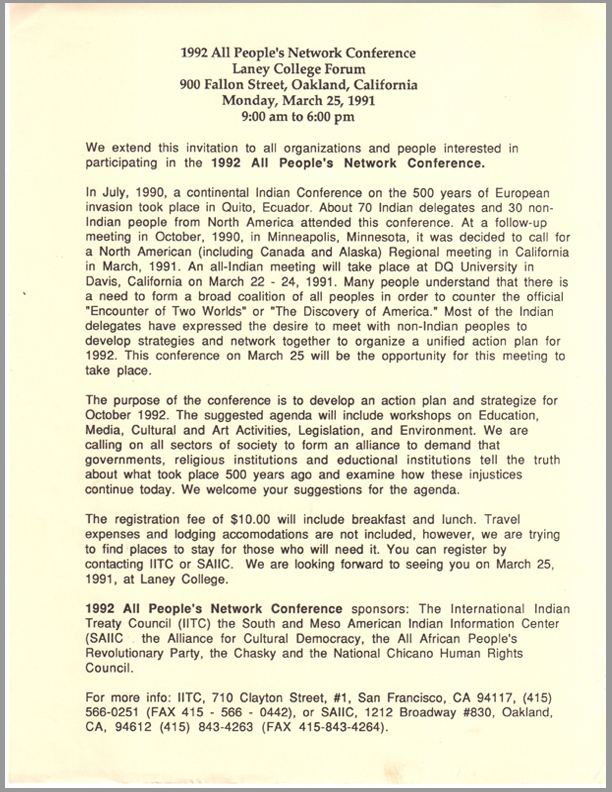
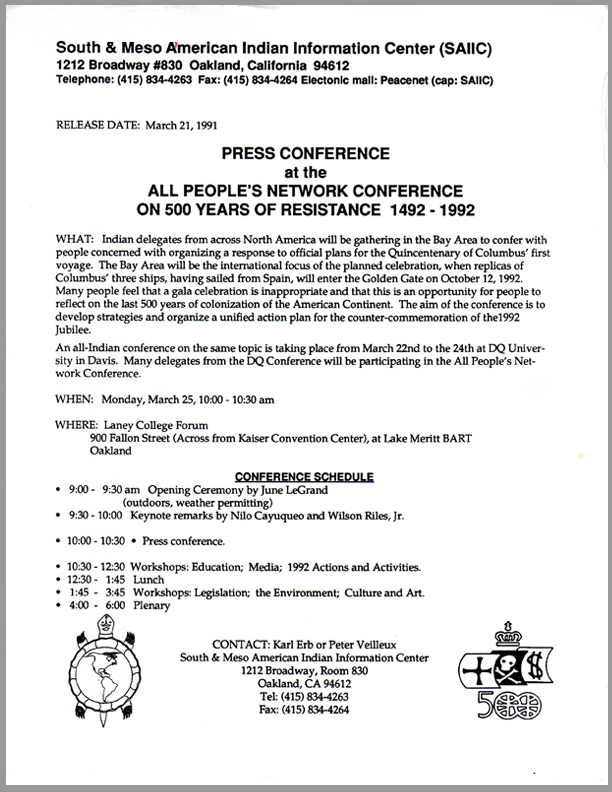
I invited two friends to come with me, Mark and Nancy Gorrell, both of
whom would go on to play important roles in Berkeley’s Indigenous
Peoples Day. I had been working closely with both of them in Berkeley
city politics. We were staff of the newsletter of Berkeley Citizens
Action, the local progressive
coalition. I was editor, Mark did layout, and Nancy was the
illustrator. Mark was also a leader of the Berkeley Ecology Center.
As I entered the conference, a very tall, powerfully built Native man
with long braids pulled me aside, introduced himself, and said he
wanted to show me something. Lee Sprague, Potawatomie from Michigan,
member of the Little River Bank of Ottawa Indians, unrolled a set of
architectural plans for what he called the Turtle Island Monument, a
large sculpture of a turtle surrounded by plaques with the names of
Native nations, and beneath it, a time capsule. Turtle Island was the
American continent. According to Lee, there was no monument to Native
people in this country, so he was gathering support to have it built,
and he had heard that Berkeley might be a possible place. He introduced
me to the architect, Marlene Watson, Navajo. We chatted for a while as
the auditorium filled.
I saw Millie Ketcheshawno with a group and touched base with her. She
introduced me to Dennis Jennings, a Sac and Fox man who had been with
her on Alcatraz during the 1969-1971 occupation, and later worked for
IITC before Tony Gonzales became director. With Dennis and Millie were
Bernadette Zambrano, Lakota Hardin, and several others. I also met
Gabriel Hernandez and Ariana Montes, from the National Chicano Human
Rights Council and the Chicano Moratorium; Dorinda Moreno,
organizer for the Peace and Dignity Journeys; and Nina Serrano, who had
a show on KPFA radio. All of these people, and
others I met that day, would make important contributions to the
counter-quincentennial and Indigenous Peoples Day.
The conference opened with a ceremony of burning sage, led by two
spiritual leaders who had also attended the Quito Encuentro: June
Le Grande and my old roommate and mentor Ed Burnstick.
June was also the keynote speaker: “We need to bring out the truths of
history and of the present, for the sake of all the unborn
generations,” Le Grande said. “We’ve got to educate the educators. Our
schools need to teach the facts, not the falsehoods that fill many of
the books today.”
Inspired speeches by SAIIC director Nilo, Oakland Councilmember Wilson
Riles, Jr., and Betty Kano, National Coordinator of ACD, detailed how
the invasion that Columbus led caused devastation to Indian
civilizations, and how this oppression continues today.
“After all the destruction and violations of human rights, repression
of indigenous people and devastation to the earth,” Nilo said, “they
are trying to impose a New World Order, which for us is the same order
of oppression we have been suffering under for 500 years. We need to
say ‘no’ to the official celebration.” [3]
Betty Kano said, “The 500 Years of Resistance challenges us to struggle
together against the New World Order and to work together for the
future of the planet for the next 500 years.”
Riles, a leader in the Bay Area Free South Africa Movement, proposed
that the Quincentennial get back to the original meaning of the
Biblical word “Jubilee,” which signified that every fifty years all
land would revert to its original owners and all debts would be
forgiven.
At the press conference that followed, Tony Gonzales explained, “The
D-Q gathering planned major events on behalf of our ancestors, those
that have gone before us. And it is from this spiritual and inspired
position that we will move the agenda forward for 1992 and beyond, all
for the love of our coming generations.”
We spent most of the rest of the day in workshops, three in the morning
and three in the afternoon. The morning workshops were: 1992
Activities, Actions and Networking; Media; and Education. In the
afternoon were Legislation; Environment; Culture and Art. Each workshop
developed an action plan for its area of discussion.
Then at 4:15 each workshop reported back to the plenary.
After hearing all the reports and recommendations, the plenary
basically affirmed and consolidated the most important resolutions of
the earlier All-Native Conference at D-Q:
1992 All People's Network Conference
1. Declare and reaffirm
October 12, 1992 as International Day of Solidarity with Indigenous
Peoples.
2. Advocate for treaty rights and non-treaty
indigenous Nations.
3. Encourage legislation that liberalizes border
crossing. We do not recognize borders.
4. Join in support of no energy or material
consumption on October 13, 1992.
5. Call on the United Nations to sponsor a conference
on 1992-1993 activities for indigenous peoples.
6. Communicate to the Pope our indigenous point of
view regarding the 500 year commemoration.
7. Coordinate common dates in which indigenous peoples
can join together in a common effort, for example, quarterly at season
changes (similar to Earth Day).
8. Call to the Churches to apologize and support an
indigenous perspective of 1992.
9. Call on the European Common Market to not invest in
Latin American countries where governments are violating human rights.
10. Demand the restriction of landing of the three
ships, the Nina, the Pinta and the Santa Maria.
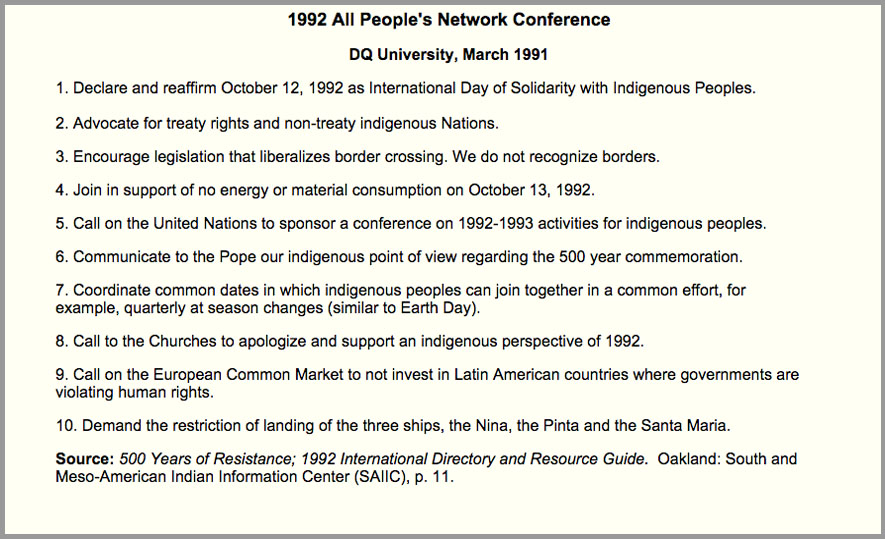
The universal consensus was to form a new organization to carry on the
work of the coalition. The Diné (Navajo) elders in attendance
said we needed to include the word “resistance” and the number “500” in
our name. Thus we became RESISTANCE
500.
We empowered the conference organizers to proceed with follow-up
meetings leading to actions. We divided the Bay Area into five task
force areas: San Francisco, Oakland, Berkeley, San Jose, and Other.
Almost everyone signed up to join a task force. So at the end of
deliberations a new all-people coalition emerged on March 25, 1991,
RESISTANCE 500, with
a plan for
leading coordinated actions to counter the officially planned “Jubilee”
commemoration of Columbus’s invasion.
RESISTANCE 500
Each local Resistance 500 task force began to hold meetings, and once a
month we all came together at Intertribal Friendship House (IFH) in
Oakland, to report on our progress, exchange ideas, and coordinate
efforts.
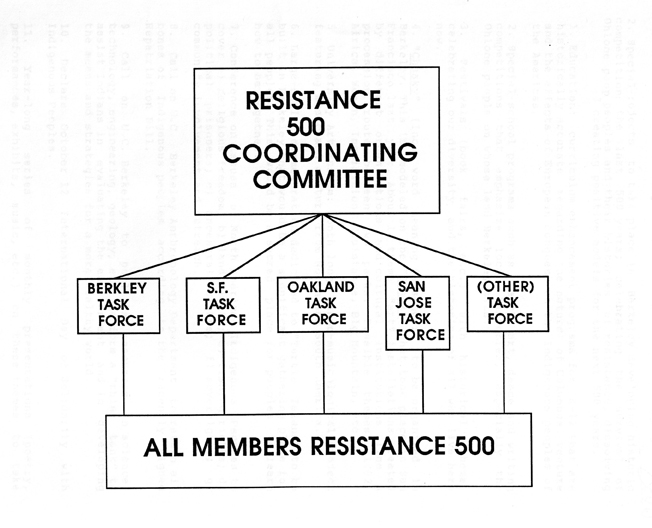
The Bay Area urban Indian community's roots went back to the 1950s when
large
numbers of Native people from all over the US were lured off
reservations and rural areas and brought here with promises of jobs by
the Bureau of Indian Affairs’ Relocation Program, which was connected
to their “termination” policy of disbanding all tribes by withdrawing
recognition. Most of the early community were young single people and
young families. West coast cities were focuses of the program, and the
Bay Area wound up with one of the urban highest concentrations of
American Indian populations in the nation. Indian people from many
tribes, reservations and rural areas adjusted to urban living by
creating a network linked by culture and shared experiences.
Intertribal Friendship House, today one of the oldest urban Indian
organizations in the country, became a sanctuary, a center for mutual
self-help, nurturing numerous people through difficult times, a
gathering place for both newcomers and their descendants. The
Friendship House Wednesday Night Dinner became a weekly social ritual
binding the community together. IFH emerged as the heart of a new,
cooperative, multi-tribal Indian community. A new intertribal personal
identity of “urban Indian” emerged. It was only natural that IFH became
the center for Resistance 500 organizing, with the hospitality of Jim
Lamenti, the director, his wife Evelyn Lamenti, Susan Lobo, Carol
Wahpepah, Betty Cooper, and all the numerous IFH family. We held our
meetings on Wednesday nights, after the traditional dinner.
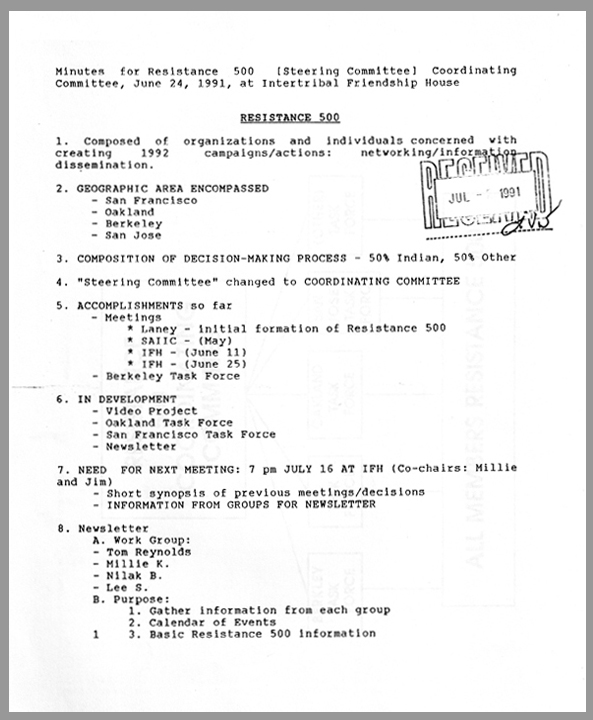
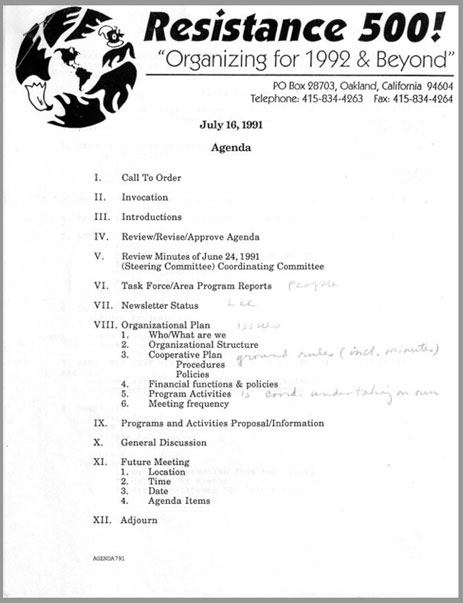
Berkeley Resistance 500 Task Force
In Berkeley, our growing group continued to follow through on the plans
already in progress informally with Mayor Hancock, and we made
presentations to
different city commissions, who almost entirely greeted our efforts
with
enthusiasm. The Peace and Justice Commission and the
School Board recommended to the Berkeley City Council to set us up as
an
official city citizen task force, “to develop, recommend and help
implement activities
for the 500 year anniversary...that present an alternative view to the
traditional Eurocentric presentations of this event in ways that will
involve and inform the community.”
City Council Sets Up Task Force
So the Berkeley City Council voted
unanimously to approve the Berkeley Resistance 500 Task Force as an
offical
city body.
They empowered us to investigate the issue of the upcoming
Quincentennial, and asked us make recommendations as to how the city of
Berkeley should respond.
At that point our real work real just beginning. We already knew that
we were going to propose replacing Columbus Day. But we needed to
educate and
lobby every public body in the city to gain citywide support for the
idea that Indigenous Peoples Day fitted with the values of the people
of Berkeley much more than celebrating Columbus with a holiday.
From the beginning we decided that our group would be at least 50%
Indigenous, which we almost always accomplished, without ever turning
anyone away for that reason. We used a simple consensus decision making
process, with the stipulation that on specifically Indigenous questions
only Native people would be the decision makers, while nonNative people
would step aside.
Many people participated in the Berkeley Resistance 500 Task Force that
first year, and in its subsequent transformation into the Berkeley
Indigenous Peoples Day Committee. Among the regulars were Dennis
Jennings, Millie Ketcheshawno, Lee Sprague, Bernadette Zambrano,
Gabriel Hernandez, Ariana Montes, Ken Roubideaux, Marlene Watson, Nancy
Gorrell, Mark Gorrell, Bonita Sizemore, John Bellinger, Marilyn
Jackson, Patricia Brooks, Roberto José García, Betty
Kano, Pennie Opal, Nancy Delaney, Les Hara, Paul Bloom, Mary Ann
Wahosi, Nancy Schimmel, Diane Thomas, Eileen Baustian, Alfred Cruz,
Audry Shabaas, Barbara Remick, Beth Weinberger, Beverly Slapin, Cece
Weeks, Chris Clark, Cindy Senicka, Susan Lobo, Garrett Duncan, Jennifer
Smith, Jos Sanchez, Judy Merriam, Lincoln Bergman, Michael Sherman,
Noele Krenkel, Robert Mendoza, Regina Eisenberg, myself, and many more.
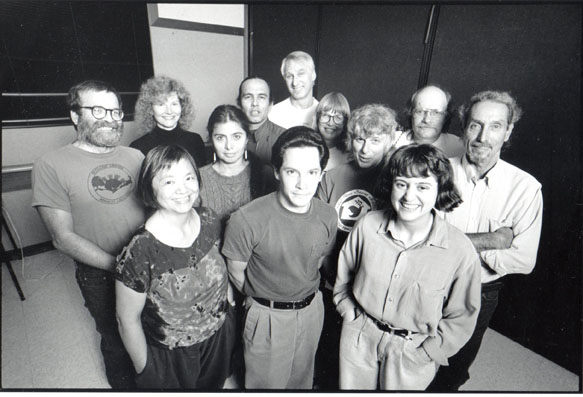
Part of the Berkeley
Resistance500 Task Force at a meeting.
L-R Back: Noele Krenkel, Dennis Jennings, John Curl,
Nancy Gorrell,
_____.
Center: Mark Gorrell, Bernadette Zambrano, Nancy
Delaney, Roberto
José García
Front: Patricia Lai Ching Brooks, Gabriel Hernandez,
Ariana Montes
[Photographer unknown]
We elected Dennis Jennings to be the Coordinator of the first Berkeley
Indigenous Peoples Day, for which we paid him a very modest stipend,
primarily out of the grant from the city, supplemented by small grants
from the Vanguard Foundation and the Seventh Generation Fund. Dennis
was our unanmous choice because of his strong leadership qualities, his
organizing abilities, his
dedication to social justice, his commitment to Indigenous and
environmental renewal.
Mayor
Hancock arranged for Dennis to work out of a desk at city hall,
graciously provided by Councilmember Nancy Skinner in her office. Mark
Gorrell
knew how to steer our way through the city labyrinth very well from his
work at the Ecology Center and as an architect, and I knew the city
machinery from my work on the West Berkeley Plan and as a member of the
Berkeley Citizens Action steering committee. The Gorrells’ house became
our regular meeting place.
Other R500 Activities
The San Francisco, Oakland, and San Jose Resistance 500 groups also
lobbied their mayors and councils to set up city task forces similar to
Berkeley’s, but without success. Nevertheless all the groups continued
moving
forward together. The Resistance 500 coalition continued to hold
monthly coordination meetings at Intertribal Friendship House, to plan,
coordinate, and
carry out activities around the Bay.
It seemed like almost every progressive cultural and
political group was coming on board Resistance 500. Although all were
not totally coordinated, all fed energy into each other. Since the Bay
Area was the scheduled
center of the national Quincentennial “Jubilee” celebration of
imperialism, colonialism and genocide, the region also became central
to the resistance. Many events began to take shape. The
counter-quincentenary
movement in the Bay Area became a whirlwind of activities. The
level of excitement was very high, in part because the official
Quincentennial “Jubilee” was so odious.
This archive and narrative is focused on Berkeley partly because we
were the only group who actually succeeded in instituting
permanent changes through our city council. However, numerous groups
accomplished important and
consciousness raising activities focused on 1992.
The Resistance 500 Directory eventually listed 85 affiliated groups.
IITC Alcatraz Sunrise Ceremony
The 1969 occupation of Alcatraz island in San Francisco Bay,
still physically dominated by the deserted prison, by a
group of Native college students calling themselves Indians of All
Tribes, was the spark that reignited North American Indian activism and
the catalyst for many profound and permanent changes. It transformed
how Native people saw their own culture, rights, and identity; it
changed the relationship between Native and nonNative people in the US;
it led to the transformation of the federal government’s policy from
genocidal
“termination” to Indian self-determination. The importance
of Alcatraz cannot be overstated. We in Resistance 500 were most deeply
honored that Millie Ketcheshawno, Dennis Jennings, and others involved
with the original occupation were now participating closely in our
project.
In
1975 the International Indian Treaty Council had begun the annual
tradition of commemorating the 1969-1971 occupation of Alcatraz
with a sunrise ceremony on the island, every unThanksgiving Day.
Then
on October 12, 1991, IITC initiated the tradition of a second sunrise
ceremony on Alcatraz Island, celebrating
Indigenous Peoples Day. On
that occasion around 300 people, our Berkeley group among them,
ferried from San Francisco to the island, and participated in the
sacred ceremonies beside the ceremonial fire. Since this is Ohlone
land, representatives of that nation served as host and welcomed us.
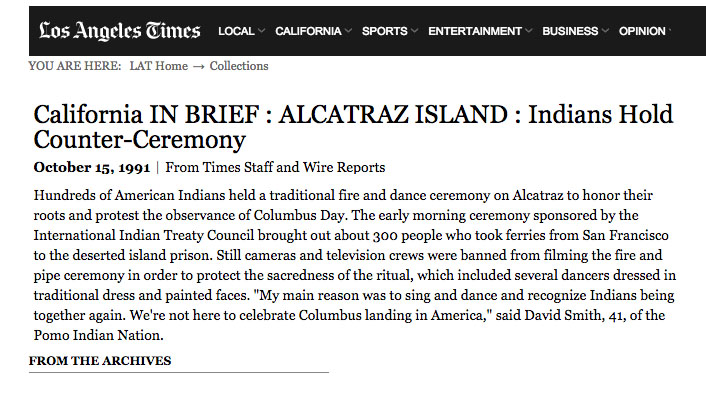
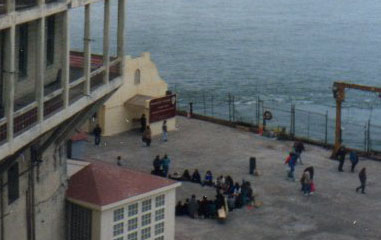
[Photo by Nancy Gorrell] [1]
UCB
Lawrence Hall of Science Exhibition
We worked on the Unversity of California's Berkeley Lawrence Hall of
Science exhibition "1492: Two Worlds of Science," which ran between
October, 1991 until January, 1992. They hired Lee Sprague as a
consultant. With Lee's assistance, the result focused on many of the
core issues. As a newspaper article at the time described, "The
exhibits use science to address painful aspects of history, such as
slavery, genocide and ecological destruction, that often have been
overlooked in discussons of Columbus' exploration."
Lee Sprague at
the Lawrence Hall of Science exhibit. [SF
Chronicle 10/10/91]
Berkeley City
Council Officially Institutes
INDIGENOUS PEOPLES DAY
The Berkeley Resistance 500 Task Force walked the concept of Indigenous
Peoples Day through the city commissions until we finally reached the
Berkeley City Council on October 22, 1991. On that date the city
council voted unanimously in our favor, and made Indigenous Peoples Day
an official Berkeley holiday when you didn’t even have to pay for
parking meters, beginning the following year, in 1992. They also gave
us a small grant to help cover our expenses in organizing events for
the year.
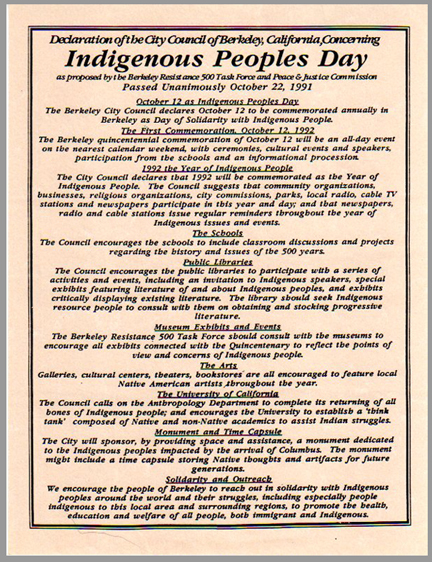
|
Declaration of the City
Council of Berkeley, California, Conceming
Indigenous
Peoples Day
as proposed by the Berkeley
Resistance 500 Task Force and Peace & Justice Commission
Passed Unanimously October 22,
1991
October
12 as Indigenous Peoples Day
The Berkeley City Council declares October 12 to be commemorated
annually in
Berkeley as Day of Solidarity with Indigenous People
The First Commemoration. October 12. 1992
The Berkeley quincentennial commemoration of October 12 will be an
all-day event
on the nearest calendar weekend, with ceremonies, cultural events and
speakers,
participation from the schools and an informational procession.
1992 the Year of Indigenous People
The City Council declares that 1992 will be commemorated as the Year of
Indigenous People. The Council suggests that community organizations,
businesses, religious organizations, city commissions, parks, local
radio, cable TV
stations and newspapers participate in this year and day; and that
newspapers,
radio and cable stations issue regular reminders tbroughout the year of
Indigenous issues and events.
The Schools
The Council encourages the schools to include classroom discussions and
projects
regarding the history and issues of the 500 years .
Public Libraries
The Council encourages the public libraries to participate with a
series of
activities and events, including an invitation to Indigenous speakers,
special
exhibits featuring literature of and about Indigenous peoples, and
exhibits
critically displaying existing literature. The library should seek
Indigenous
resource people to consult with them on obtaining and stocking
progressive
literature.
Museum Exhibits and Events
The Berkeley Resistance 500 Task Force should consult with the museums
to
encourage all exhibits connected with the Quincentenary to reflect the
points of
view and concerns of Indigenous people.
The
Arts
Galleries, cultural centers, theaters, bookstores are all encouraged to
feature local
Native American artists througbout the year.
The
University of California
The Council calls on the Anthropology Department to complete its
returning of all
bones of Indigenous people; and encourages the University to establish
a 'think
tank' composed of Native and non-Native academics to assist Indian
struggles.
Monument and Time Capsule
The City will sponsor, by providing space and assistance, a monument
dedicated
to the Indigenous peoples impacted by the arrival of Columbus. The
monument
might include a time capsule storing Native tbougbts and artifacts for
future generations.
Solidarity and Outreach
We encourage the people of Berkeley to reach out in solidarity with
Indigenous
peoples around the world and their struggles, including especially
people
indigenous to this local area and surrounding regions, to promote the
health,
education and welfare of all people, both immigrant and Indigenous.
|
However, two of the more conservative council
members were subsequently lobbied heavily behind the scenes by the
opposition, who never actually showed much of a public face. Those
councilmembers returned at their next meeting with a counter proposal
to bring back Columbus Day as a joint holiday with Indigenous Peoples
Day. But they really had little public support, so the opposition
quickly faded.
Berkeley School Board
Soon after the City Council
acted, the School Board added their support of a year of educational
activities in the schools.
Berkeley Public Library Exhibition
We set up an exhibit in the front windows of the downtown Berkeley
library, and other exhibits in glass display cases inside the
ground floor entrance way, that opened in January, 1992.
Loni organized a press conference in front of the library at the
opening of the exhibit, with Dennis, herself, and the heads of the
school board and the library. The press came out in force.
Dnnis Jennings and Loni Hancock at
press conference [Photo by John Curl]
We continued organizing for community consciousness of a year of
activities, focused on October, 1992.
Loni continued to give us her active support.
Loni receives an
honor from Dennis Banks, Darrell Standing Crow, Millie
Ketcheshawno,
John La Velle, and Floyd 'Red Crow' Westerman. [SF Chronicle 3/7/92]
Turtle Island Monument
Lee Sprague's concept of the Turtle Island Monument took on a life of
its own and had a separate trajectory throught the city processes. As
public art and a proposed structure in Civic Center ML King, Jr. Park,
it needed to pass through the Public Arts Commission and other agencies
related to the parks. Lee had a powerful presence, projecting the
rightness and purity of his vision, so doubters usually wound up
excited supporters.
Lee told many times the creation story of Turtle Island according
to his tribe. Almost every tribe had a version or variation of the
story:
|
The Creation of Turtle Island
In my people's creation stories the world was covered
with water and
all the animals were swimming. They were getting tired, so they
respectfully asked the muskrat to go under the water to see if there
was any earth. So the muskrat went down to find the earth. All of the
animals were waiting for the muskrat to reappear. They were worried for
the muskrat. Finally his body floated to the surface. The animals
looked in his paw and they found some earth. They put the earth on the
turtle's back. The rest of the animals now knew that there was earth
under the water so they each went down to get some earth, first the
loon then the duck and all of the rest of the animals. They all put the
Earth on the turtle's back. This Is how Turtle Island was created.
|
Lee described his vision of the Turtle Island Monument:
Turtle Island Monument
The Bronze Turtle In the center of the monument symbolizes
the creation of Turtle Island and sits in the center plaza. Many of the
tiles have the names of Nations and Peoples who are Indigenous to
Turtle Island. Many of the tiles are blank, representing the Nations
and Peoples who are no longer here and the languages no longer spoken
on Turtle Island.
Surrounding the center plaza, is a solar powered water fountain. The
fountain symbolizes the Oceans and the Seas that surround Turtle
Island, and Is powered by photo-voltaic system that uses the sun's
energy to move the water over the waterfalls. The photo-voltaic system
also operates the lights in the evening.
The sun's ray entering through the Turtle's eyes and nose will mark the
Summer and Winter Solstices and the Spring and Fall Equinox.
Entry to the plaza is from the four directions with the main entrance
from the east The people who live here on Turtle Island with us came
from these four directions.
Under the Turtle is a Time Capsule to be buried for seven generations.
The Inscription on the Monument/Time Capsule will say:
WE DEDICATE THIS MONUMENT
TO THE SEVENTH GENERATION
OF OUR CHILDREN'S CHILDREN,
WE GIVE TO YOU OUR THOUGHTS, HOPES AND DREAMS
FOR THE FUTURE OF ALL OF CREATION ON MOTHER EARTH.
|
The dedication of the Turtle Island Monument would become the
centerpiece of the events of the first Berkeley Indigenous Peoples Day.
Lee was confident that if the city would approve the concept, funds to
build it could be gathered primarily or entirely from outside sources.
So the cost of the project to the city was never an issue. Besides, the
old fountain in the park, originally built in the 1930s, had been
broken as long as anyone remembered and the general consensus held it
to be just an eyesore, so nobody objected to replacing it with the
Turtle Island Monument, at least not at that time.
Other Berkeley R500 Projects
We organized and participated in many projects over 1992.
On May 27, we put on a
Cultural Festival of Poetry and Music
at La Peña Cultural Center
with fifteen poets.
On May 30 we organized a Multi-Cultural
Book Fair at the gymnasium at
Berkeley High School, with nineteen vendors, author book signings,
poster sessions, storytelling, all day video showings. The R500
Education Committee, made up of Roberto José García,
Gabriel Hernandez, Nancy Schimmel, Audrey Shabbas, and Jennifer Smith,
were the central organizers.
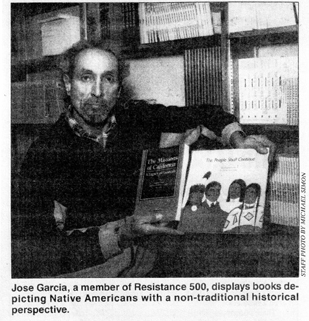 Roberto José Garcîa at the Book Fair
Roberto José Garcîa at the Book Fair
[
Daily Californian, 1/14/92]
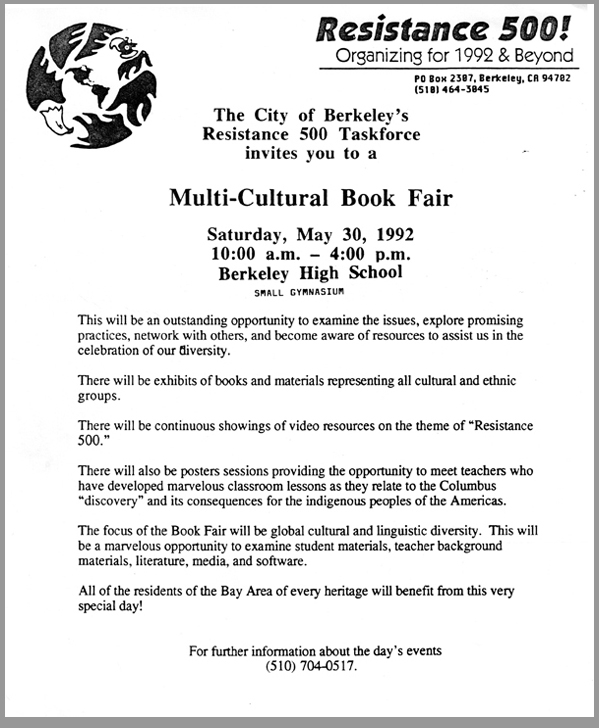
On July 29 we organized a Soapbox-Chautauqua
at the Berkeley Unitarian
Fellowship Hall, an open mike on quincentennial issues, a forum where
people of different backgrounds stepped up one by one and spoke from
the heart about indigenous peoples day. We did another Chautauqua on
September 17.
We sponsored and
some of us actually acted in a
satirical play about Columbus at nearby Mills College.
Besides operating museums in the City, the University of California at
Berkeley also operated the Black Hawk
Museum of Art, Science & Culture in the town of that name,
around 25 miles inland. A member of our group, Marilyn Jackson, pointed
this out to Dennis Jennings, who was a descendent of Black Hawk, the
great Sac and Fox chief. This led to Dennis and our group helping to
organize a weekend of Indigenous events at that location the
following spring, when the Blackhawk
Museum was actually dedicated to the Sac and Fox Nation.
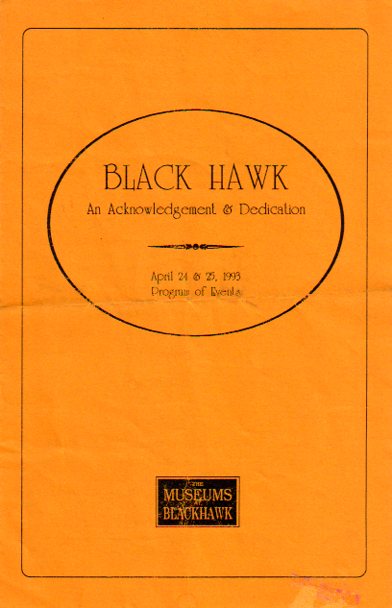
An equally important project of ours was helping to organizing a Berkeley-Yurok Nation "sister community"
relationship. For that we worked closely with Sue Masten, who
would be elected tribal chair and later president of the National
Congress of American Indians (NCIA). A group of us traveled to the
Yurok Reservation in northwestern California on the Klamath River near
the Pacific coast, and were guests of their generous hospitality. The
Berkeley City Council would approve the Yuroks as a sister community
the
following year.
As we did our work, so did the other groups in our coalition.
Resistance 500 flyers listed 68 Bay Area events between July 22 through
October, 1992.
The National Columbus Quincentenary
To understand the forces arrayed against us, we need to look more
closely at what the US government was planning for October 12, 1992.
The Christopher Columbus Quincentenary Jubilee Commission was
established in 1984, consisting of 30 members with the mission of
planning the commemoration. The original deal had been that Spain would
build the ships (at the cost of $15 million), and the Commission would
organize the US tour, which Texaco would sponsor to the tune of $5
million, with $850,000 going to the Commission. But Texaco pulled out,
leaving the Commission holding the bag. Between 1986 and 1990 the
government gave the Commission over $1 million to play with, with the
rest of their budget to be filled in from corporate donations. But by
1990 they were in a $700,000 hole, with the first director resigning
under charges of financial misconduct. Still they conjured up a new
chair and soldiered on.
The ships were scheduled to arrive in Miami in February, 1992, as the
first stop in a 20-city U.S. tour. Expenses would be absorbed by the
cities benefitting from the tour. From Miami they would sail into the
Gulf with stops in Corpus Christi, Galveston, New Orleans, and Tampa.
Then up the Atlantic coast: St. Augustine, Charleston, Norfolk,
Baltimore, Annapolis, Philadelphia, Wilmington, Atlantic City, New York
City, New London, and wind up in Boston in August. From there they
would be hoisted onto barges, towed through the Panama Canal, up the
west coast and let loose in San Francisco Bay on October 12, 1992
as the national focal point and centerpiece of the grand celebration
and hoopla. Eventually the ships would continue their historical voyage
down the Pacific coast, stopping at San Luis Obispo, Los Angeles, San
Juan de Capistrano and finally docking in San Diego.
To organize the Bay Area activities, an independent non-profit
committee was set up under the joint honorary chair of the mayors of
San Francisco, Oakland, and San Jose, and told it needed to raise and
contribute $1.5 million.
In June, 1990, San Francisco Mayor Art Agnos and George F Jewett, Jr.,
Chairman of the San Francisco Bay Christopher Columbus Quincentenary
Jubilee Committee, trying to drum up enthusiasm and support, sent the
following letter to other Bay Area mayors:
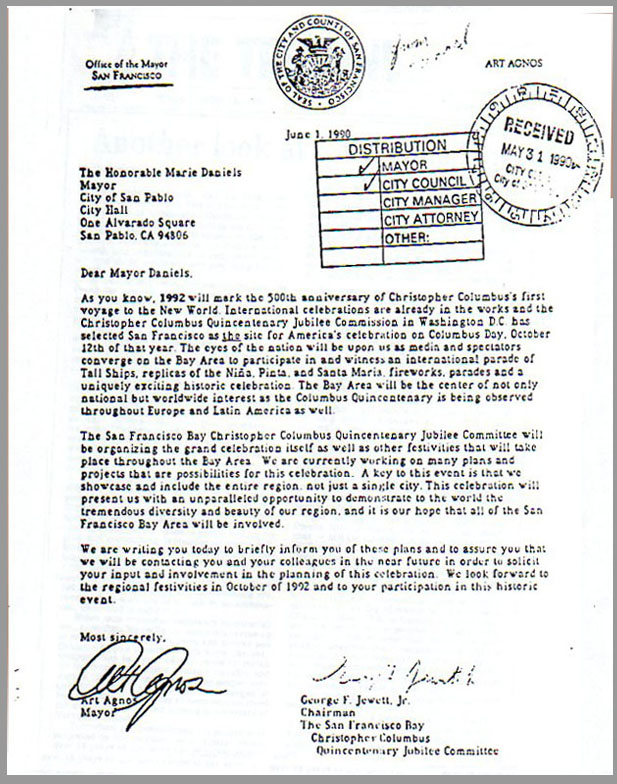
Office of the Mayor, San Francisco
June 1, 1990
The Honorable Marie Daniels, Mayor, City of San Pablo
City Hall, One Alvarado Square, San Pablo. CA 94106
Dear Mayor Daniels,
As you know, 1992 will mark the 500th anniversary of Christopher
Columbus's first voyage to the New World. International celebrations
are already in the works and the Christopher Columbus Quincentenary
Jubilee Commission in Washington DC has selected San Francisco as the
site for America's celebration on Columbus Day, October 12th of that
year. The eyes of the nation will be upon us as media and spectators
converge on the Bay Area to participate in and witness an international
parade of Tall Ships, replicas of the Niña, Pinta. and Santa
Maria, fireworks, parades and a uniquely exciting historic celebration.
The Bay Area will be the center of not only national but worldwide
interest as the Columbus Quincentenary is being observed throughout
Europe and Latin America as well.
The San Francisco Bay Christopher Columbus Quincentenary Jubilee
Committee will be organizing the grand celebration itself as well as
other festivities that will take plate throughout the Bay Area. We are
currently working on many plans and projects that are possibilities for
this celebration. A key to this event is that we showcase and include
the entire region, not just a single city. This celebration will
present us with an unparalleled opportunity to demonstrate to the world
the tremendous diversity and beauty of our region, and it is our hope
that all of the San Francisco Bay Area will be involved. We are writing
you today to briefly inform you of these plans and to assure you that
we will be contacting you and your colleagues in the near future in
order to solicit your input and involvement in the planning of this
celebration. We look forward to the regional festivities in October of
1992 and to your participation in this historic event.
Most sincerely,
Art Agnos, Mayor
George F. Jewett, Jr., Chairman
The San Francisco Bay Christopher Columbus Quincentenary Jubilee
Committee
|
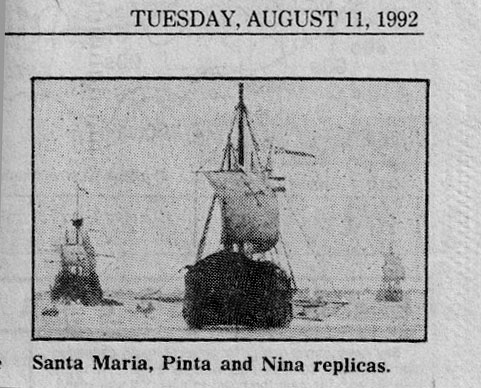
Oakland
Tribune
But on August 10, 1992, soon after the ships arrived in
Boston Harbor. the co-chair of the Columbus Quincentrenary was sad to
announce that the ships would not continue their voyage to the west
coast. "The technical and logistical obstacles would daunt even a Don
Quixote," she said.
So two months before the quincentenary, they folded. The whole
elaborate shebang was cancelled. We had won.
In an article about it, the Oakland
Tribune wrote,
The cancellation was called a
minor victory by opponents of the traditional Columbus Day holiday who
would rather celebrate the lives of the indigenous people — whose fates
were forever changed by Columbus' landing. Lee Sprague, a Native
American artist, saw the ships on their visit to New York, and hated
the thought of them coming to the Bay Area. "The Columbus ships were
the forerunners of these huge military aircraft carriers. They were
both the instruments of suppression and occupation."
The truth was that the San Francisco Bay Christopher Columbus
Quincentenary Jubilee Committee, and the other west coast cities, had
all been unable to raise any funds, much less $1.5 million, because
Resistance 500 and all our associated groups had done our job well.
The people of the Bay Area didn't want to celebrate what the ships
stood for. Instead, we wanted to celebrate Indigenous Peoples Day.
The
first Berkeley Indigenous Peoples Day
The schedule of the first Berkeley Indigenous Peoples Day began
to take shape.
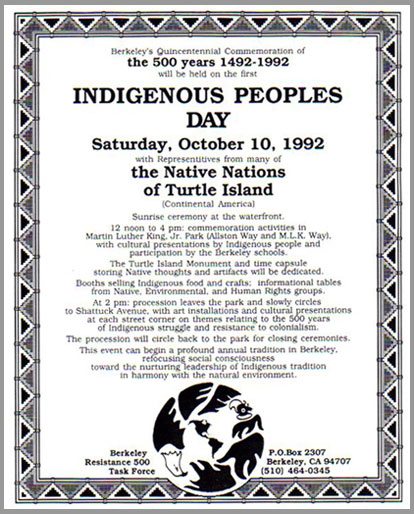
|
Berkeley’s Quincentennial Commemoration of
the 500 years 1492-1992
will be held on the first
INDIGENOUS
PEOPLES DAY
Saturday, October 10, 1992
with Representatives from many of
the Native Nations
of Turtle Island
(Continental America)
Sunrise ceremony at the waterfront.
12 noon to 4 pm: commemoration activities in
Martin Luther King, Jr. Park (Allston Way and M.L.K. Way),
with cultural presentations by Indigenous people and
participation by the Berkeley schools.
The Turtle Island Monument and time capsule
storing Native thoughts and artifacts will be dedicated.
Booths selling Indigenous food and crafts; informational tables
from Native, Environmental, and Human Rights groups.
At 2 pm: procession leaves the park and slowly circles
to Shattuck Avenue, with art installations and cultural presentations
at each street corner on themes relating to the 500 years
of Indigenous struggle and resistance to colonialism.
The procession will circle back to the park for closing ceremonies.
This event can begin a profound annual tradition in Berkeley,
refocusing social consciousness
toward the nurturing leadership of Indigenous tradition
in harmony with the natural environment.
|
Dennis Jennings, Bernadette Zambrano and Sal García
designed and produced a large
poster:
Poster design
by Sal García, Dennis
Jennings, Bernadette Zambrano.
The text at the top:
Indigenous People's Day
Saturday, October 10, 1992 •
Martic Luther King, Jr. Park (Behind City Hall) • Berkeley • California
To express appreciation for our
survival and acknowledgement of our contribution to today's world
commmunity and in commemoration of our fallen patriots.
Sunrise—Ceremony at the Berkeley
waterfront
10:00 AM—Gather in the park
Noon—Dedication of the Turtle
Island Monument
2:00 PM—Motorcade leaves
2:00 to 4:00 Procession to
Shattuck Avenue.
The text at the bottom:
—Purpose —
1. A commemoration of the now
extinguished fires of native nations
long gone and of the indigenous patriots and martyrs who stood for
the values of Indigenous people.
2. To acknowledge the
contributions of indigenous peoples to today’s
modern society in arts, medicine, education, science; agriculture and
government.
3. To affirm the survival and
existence of tribal peoples all over the
globe and to educate the public of the importance and symbiotic
nature of our common destiny and that of the natural world.
|
We continued organizing for the day's events:
The Procession and Indigenous Peoples Parade
We planned the Procession and
Indigenous Peoples Parade as a version of the Chasky. We would bring
the event downtown into the heart of the city. The City agreed to block
off three blocks of Shattuck Avenue, from Allston Way to Kitteridge
Street, between 2
and 4 pm. It was a moving cultural festival, with music, speakers,
poetry, street theatre,
informational tables and crafts booths. The procession left the park,
walked to Shatuck, and continued down the blocks, stopping for each
event, until we reached the Main Library, where we circled back to the
park for closing ceremonies.
Included in the Procession and Tabling were Grupo Maya Kusmej Junan,
Antenna Theater, Without Reserve, Earth Circus, Pearl Ubungen Dancers.
Musicians Yahuar Wauky, Ingor Gaup, Mahal, Will Knapp. Big Mountain
Support Group, Guatemala News and Information Center, PEN Oakland,
AWAIR, Roots Against War, Middle East Children's Alliance, Western
Shoshone (100th Monkey), Rainforest Action Network, ACD, Ecology
Center, Sarah James' Alaskan Native group, Chicano Human Rights
Council, Berkeley Citizens Action, Earth Island Institute, Sister City
El Salvador, Oyate, Ecumenical Peace Institute, Real Magic, Cop Watch,
Bay Area Landwatch, Labor Committee on the Middle East, Heyday
Books/News from Native California. Poets Odelia Rodriguez, Dennis
Jennings, Sheila Medina, Floyd Salas, John Curl. Speaking on Shatttuck
Avenue were Millie Ketcheshawno, Gabriel Hernandez, Lee Sprague, Dennis
Jennings, Roberto García, Mark Gorrell.
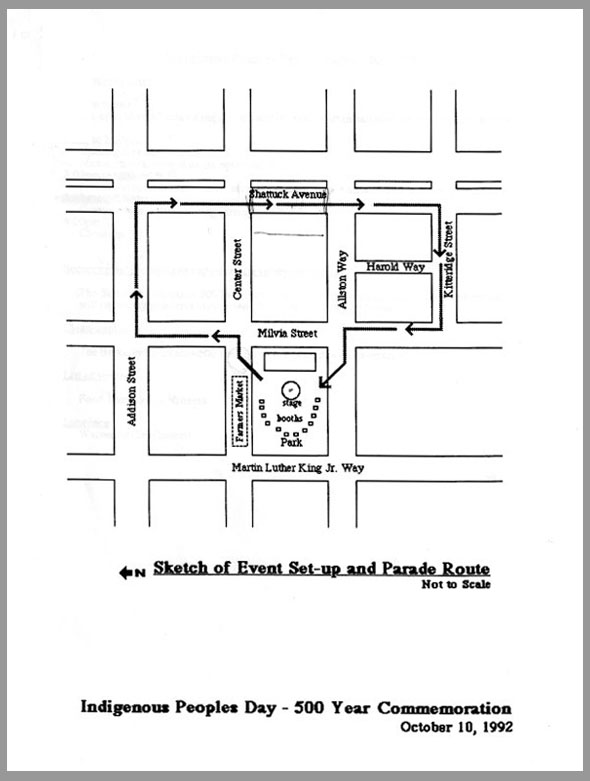
Towards the end of the events, a Motorcade would leave to take the
elders and dignitaries who participated in the earlier Turtle Island
Monument dedication ceremonies down to Intertribal Friendship House in
Oakland, where they would join the events that the Bay Area Regional
Indian Alliance was organized there, the “1st Nations Intertribal
Gathering,” with the theme “Truth In History.” The IFH event, running
12 noon to sundown, at 4 pm would hold a reception for the Indian
Nations representatives arriving from the Berkeley Turtle Island
Monument dedication. At the same time that Dennis Jennings was our
Berkeley coordinator, he and others were also members of the BARIA
organizaing group.
The mayor's office sent out a press release for the Turtle Island
Monument dedication
ceremonies:
The Sunrise Ceremony
The sunrise ceremony, presided over by Galeson EagleStar, took place on
a hill at Cesar Chavez Park at the
Berkeley waterfront.
The Dedication
The dedication of the Turtle Island Monument at the first Berkeley
Indigenous Peoples Day:
[Photo by Nancy Gorrell] [1]
Other
1992 Resistance 500 Events
Numerous other Resistance 500 events were taking place in the Bay Area
and elsewhere. Here are a few of them. [4]
Chasky
On Saturday, October 4, the week before the quincentenary, the third
Chasky was held in San Francisco. It began in Dolores Park, and
again finished in La Raza Park with rituals, music, poetry, dance, and
speakers. The performance installations en route were again coordinated
by Luis Vasquez, and included Wise Fool Puppet Intervention, Teatro ng
Tanan, Pearl Ubungen Dancers, Earth Circus, Francisco X. Alarcon, Roots
Against War, Grupo Maya Kusamej Junan, and others. But after the fourth
Chasky in 1993, the organizing group disbanded, and spoke of having
lost direction, perhaps because the event was more focused on
opposition than on positive energies working to shape the future. (It
was however revived one more time in 2000.)
AIM Tribunal
Between October 9 - 11, the Amercan Indian Movement (AIM) organized a
three-day International Tribunal of Indigenous People and Oppressed
Nationalities in the USA.
IITC Conference and Concerts
IITC held the 14th
International Indian Treaty Conference October 5-9 at San Francisco
State University, with a focus on the struggles of California Indians
and plans for the 1993 International Year of the World's Indigenous
Peoples. Special guest from the UN was Dr. Miguel Alfonso Martinez.
The Treaty Council also sponsored three days of Resistance 500 concerts.
The first two were at Shoreline Ampitheater in Mountain View. On
October 10 was All Our Colors: the
Good Road Concert, with Circle of Elders, Carlos Santana, Oren
Lyons, Thomas Banyaca John Trudell, The Wagon Burners, Jackson Browne,
Mickey Hart. John Lee Hooker, Red Thunder, and others. On October 11
was Healing the Sacred Hoop: The
Next 500 Years, with Floyd "Red Crow" Westerman, Bonnie Raitt,
Buffy Sainte-Marie, The Cult, Don Henley, and others. On October 12,
they offered a free concert at Crissy Field in San Francisco's Golden
Gate Park, with many of the same performers.
AIM Demonstration Against the Re-enactment
Undaunted by the cancellation of the arrival of the Columbus
ship replicas, the San Francisco Italian-American community carried on
with plans for their traditional Columbus Day Parade and Re-enactment
of the Columbus Landing at Aquatic Park, in which a local dressed up in
a Columbus costume arrives in a small boat, falls on one knee and
claims San Francisco for the King and Queen of Spain. Since they
traditionally thought of October 12 as a celebration of
Italian-American culture, many of them were extremely dismayed by the
situation. (Eventually clearer heads would prevail, and a couple of
years later they began to change the name of the occasion to
Italian-American Heritage Day.)
On October 11, 1992, AIM held an important Demonstration Against the
Re-enactment of the Columbus Landing at Aquatic Park in San Francisco,
followed by a march. During the demonstration the Peace Navy, with over
150 boats, strung
ropes between their vessels, and actually prevented the Columbus boat
from landing. After that, we marched in a counter-parade.
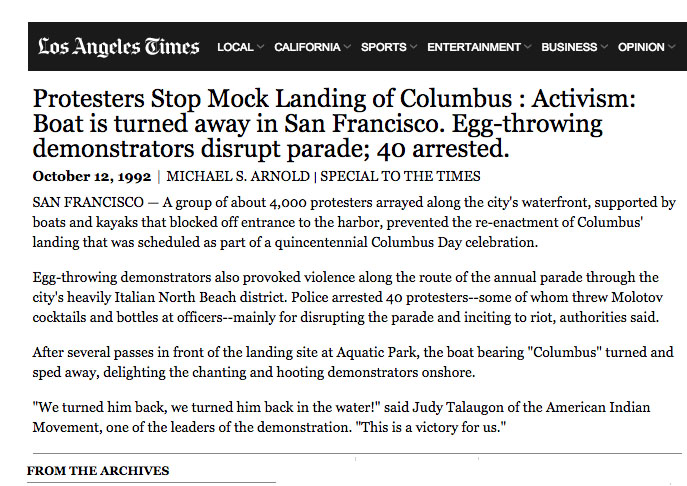
Alcatraz Sunrise Ceremony
On October 12,
1992, the Treaty Council (IITC) held another Alcatraz sunrise ceremony:
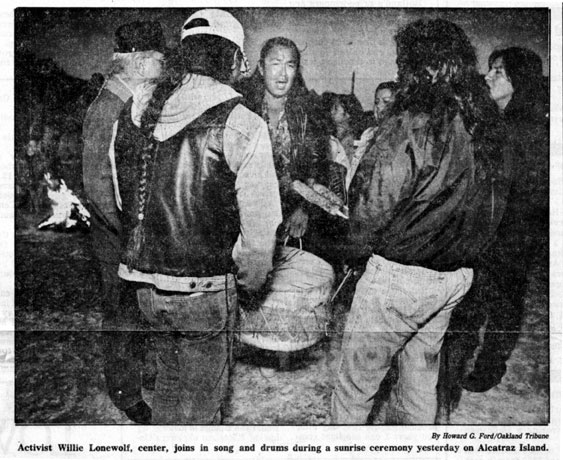
1992 Sunrise
Ceremony
on Alcatraz Island [Oakland
Tribune 10/13/92]
UC Teach-In
On October 12 a teach-in was held at UC
Berkeley's Sproul Plaza on Truth In History.
[Oakland Tribune 10/13/1992]
UnPlug North America
On October 13 the Bay Area Regional Indian Alliance
(BARIA)
and the Indigenous Environmental Network sponsored a Day of Rest to
Unplug North America to Give Mother Earth A
Rest, originally initiated by the Indigenous Environmental Network.
They asked that we "not participate in dominant culture activities," to
use only sustainable energy, and to not conduct any business
transactions.
Peace
and Dignity Journeys
Peace and Dignity Journeys considered one source of their
inspiration to be the Andean prophesy of the condor and eagle, and also
looked
to prophesies of spiritual running passed down from elders in many
parts of the Americas. Those prophesies foretold that spiritual
running would help the Native nations to reunite: “we are like a
body that was broken up into pieces and this body will come back
together to be whole again.” Dorinda Moreno, of Hi-Tec Aztec
Productions, was a key Northern
California organizer. Their first run in 1992 was to be “a prayer
to heal our nations” and the world. The plan was that runners would
begin in April 1992 from Alaska running south and from Argentina
running north. The runners would pass through numerous Indigenous
communities, where they would share wisdom and collect ceremonial
objects symbolically containing the prayers of all the many Native
peoples, and all would come together for final ceremonies at the base
of the Pyramid of the Sun in Teothuacan, Mexico on October 12, 1992.
The first Peace & Dignity Journey of 1992 was a great success, and
would be renewed with a run every four years thereafter.
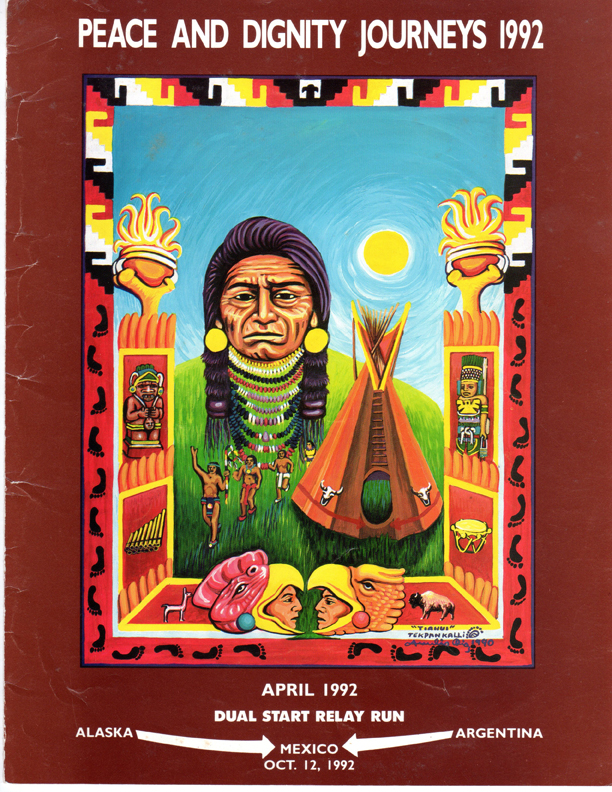
LOOKING FORWARD
By the end of October, 1992, the
mission of the
Berkeley Resistance 500 Task Force was over. Berkeley had become the
first city in the world to get rid of Columbus Day and annually
commemorate October 12 as
Indigenous Peoples Day. [4]
Our group made a smooth
transition. We became the Indigenous Peoples Day Commmittee, and as
such in 1993 we decided that the most appropriate way to celebrate was
with a pow wow, so geared up again to organize the first Berkeley
Indigenous Peoples Day Pow
Wow and Indian
Market.

NOTES
1. Unless otherwise stated, all photos are by Nancy Gorrell or
from her photo collection.
2. The following year, in 1991, IITC would bring back their
proposals that the UN declare a Decade of Indigenous Peoples and
International Indigenous Peoples Day. The IITC proposals would finally
surface in the General Assembly in December, 1994, and UN Resolution
49/214 would declare 1995 – 2005 to be the International Decade of the
World’s Indigenous People. That was a great accomplishment. But the
conservative governments, led by the USA, would not touch October 12
and the concept of peoples,
and instead removed the "s" of peoples,
and declared the innocuous date of August 9 to be International Day of
the World’s Indigenous People. However, the governments could not
derail the movement to celebrate October 12 as Indigenous Peoples Day
in place of a celebration of Columbus's colonial and imperialist
enterprise.
3. "The Birth of Resistance 500," by John Curl, Huricán
(Alliance for Cultural Democracy), Vol 2, No. 1 & 2, Summer
1991, 3.
4. After 1992, many of the Bay Area groups which were active in
Indigenous Peoples Day and Resistance 500 between 1990-1992, shifted
their focus. The South and Meso-American Indian Information Center
(SAIIC) closed in 1999 after Nilo Cayuqueo, the director, returned to
Argentina. The Alliance for Cultural Democracy (ACD) disbanded in
1996.



